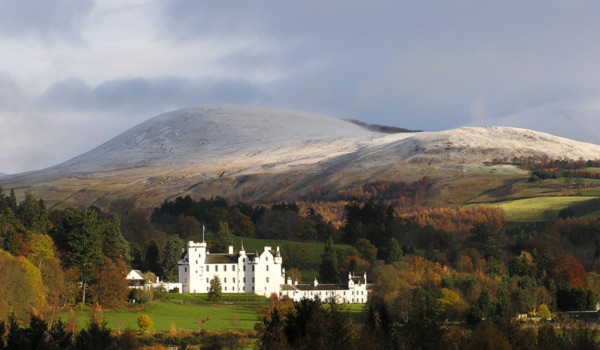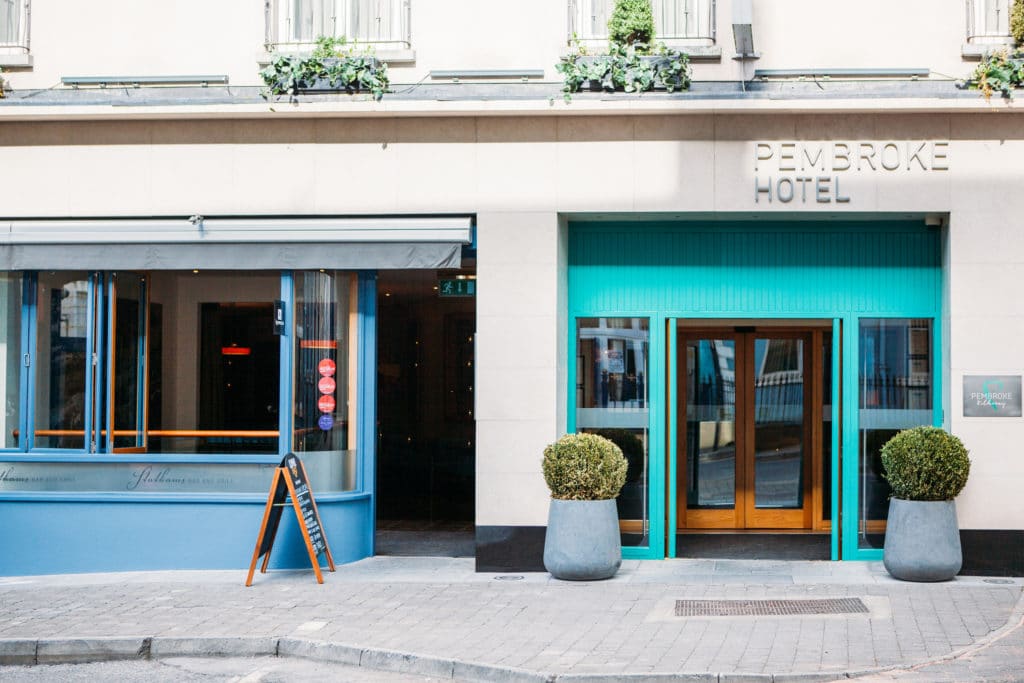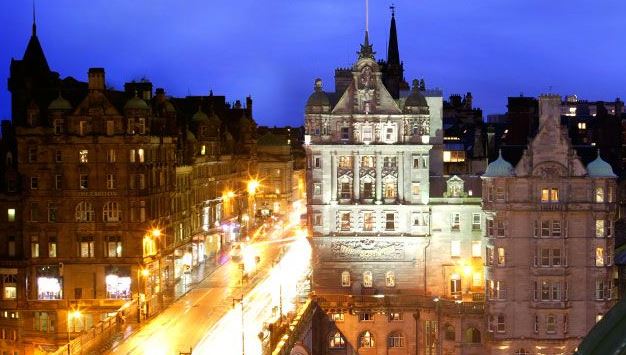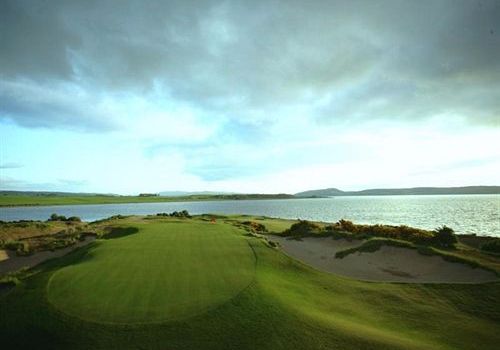- Home
- Europe
- Ireland & Scotland Tours
- 14-Night Ireland & Scotland Great Celtic Rambler
Ireland and Scotland
14-Night Ireland & Scotland Great Celtic Rambler
Self-Drive
From
$4398 $4,198 per person*
* based on 2 people traveling
One week vacationing in Ireland and another in Scotland makes for an extraordinary Celtic adventure. Staying only in boutique hotels, you’ll begin in Dublin. See the Book of Kells, shop Grafton Street, and tap your feet to Irish music. Pick up your rental car, and head to Kilkenny, a medieval gem of craft shops and fine cuisine. From there, it’s a glorious drive to Killarney—the Ring of Kerry and the Blarney Stone await. Tuck into a village on Ireland’s western coast, with the Cliffs of Moher nearby.
Fly to Scotland and the ancient capital of Edinburgh, city of heroes, villains, and royalty. Fill your soul with ancient stories and a vibrant present. Next, it’s north through the Scottish Highlands. Delight in charming towns and be amazed by National Parks. Fall under the spell of Inverness, cultural heart of the north. Revel in mountain scenery and end your journey in dynamic Glasgow.
From
$4,198 per person
Included Unique Activities
- Meet & Greet Private Transfer on Arrival in Dublin
- Enjoy a Tour & Pint at the Guinness Storehouse
- Join a Musical Pub Crawl through the Streets of Dublin
- Kilkenny Castle Admission
- Flavors of Johnnie Walker Princes Street
- Secrets of the Royal Mile & Edinburgh Castle Tour
- Cream Tea in Inverness
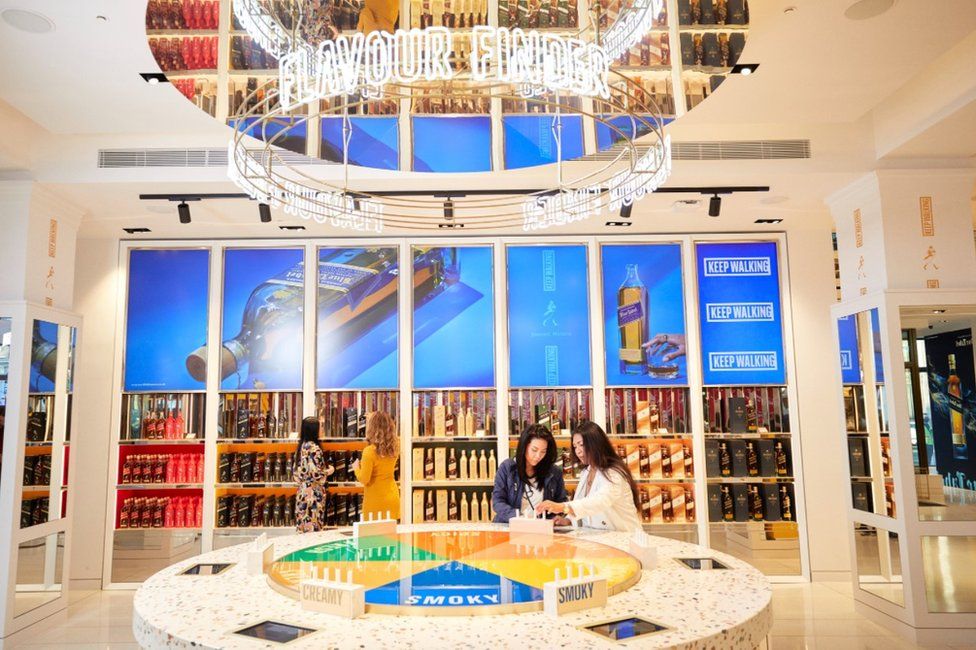
Johnnie Walker Journey of Flavor

Secrets of the Royal Mile & Edinburgh Castle
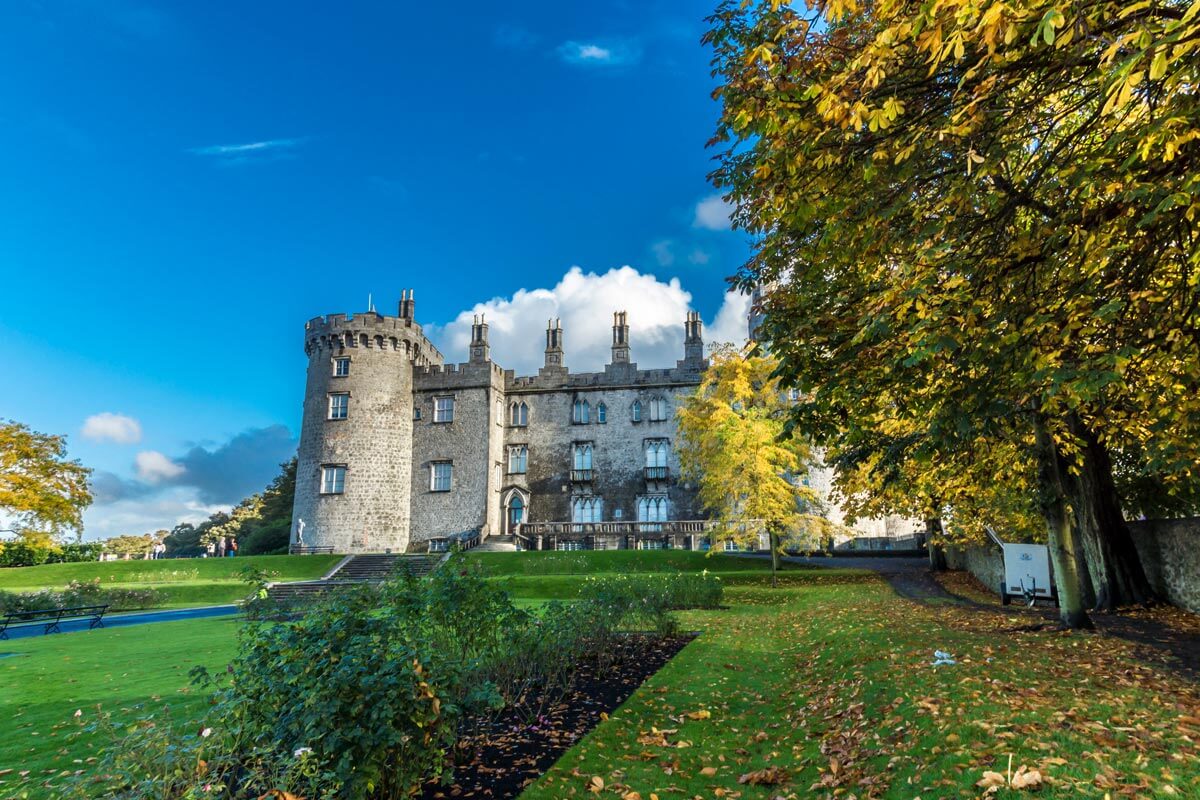
Kilkenny Castle
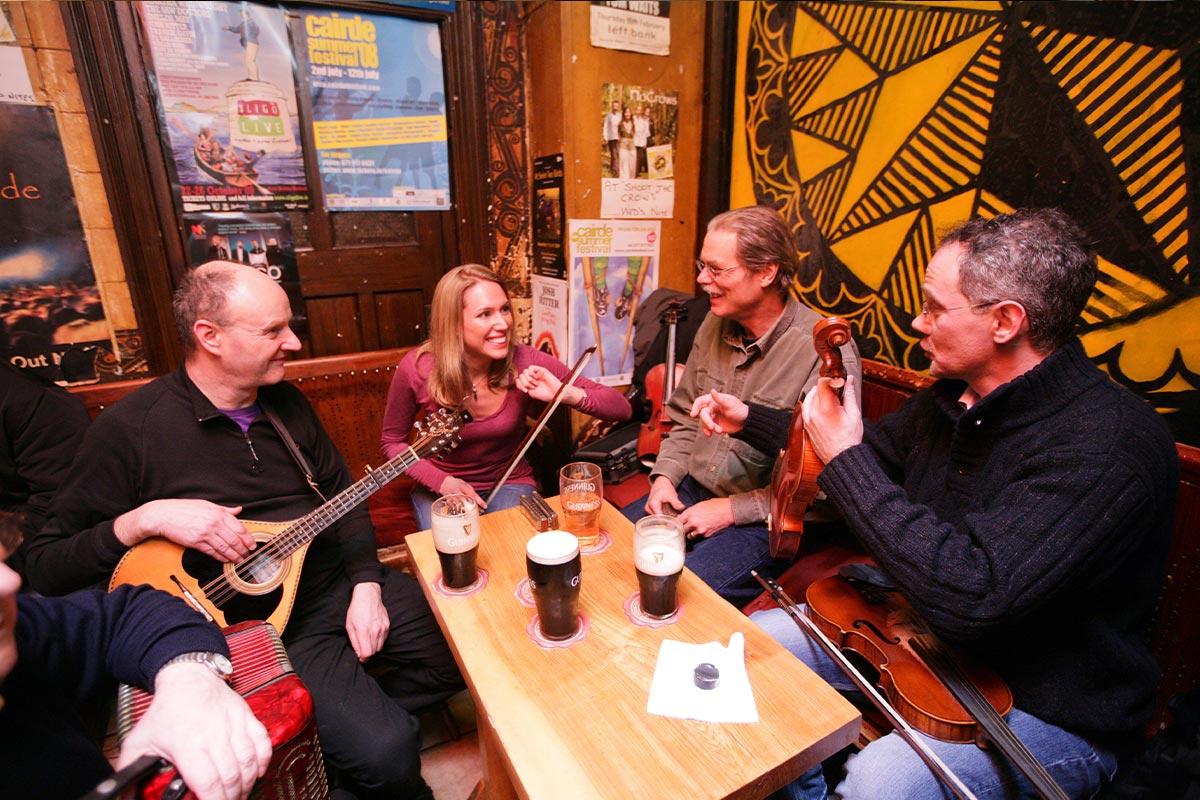
Musical Pub Crawl
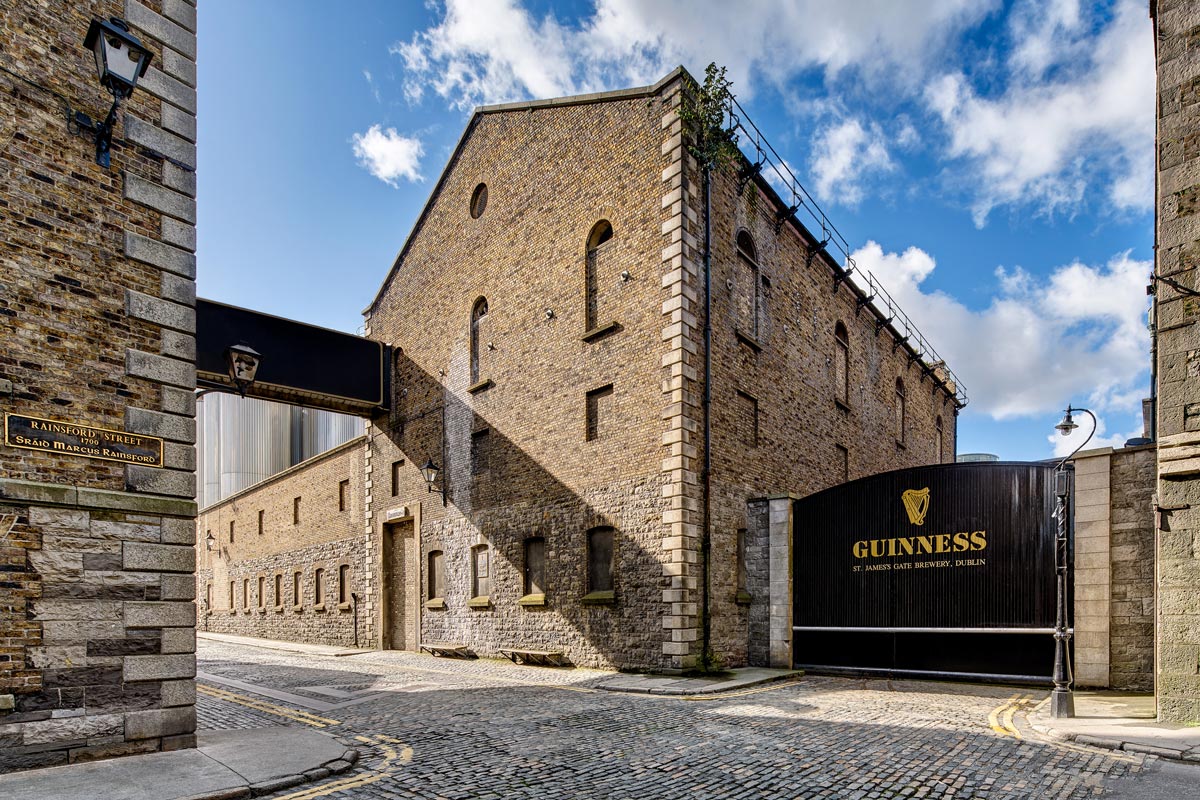
Guinness Storehouse Tour
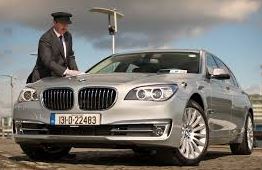
Meet & Greet Private Airport Transfer - Dublin
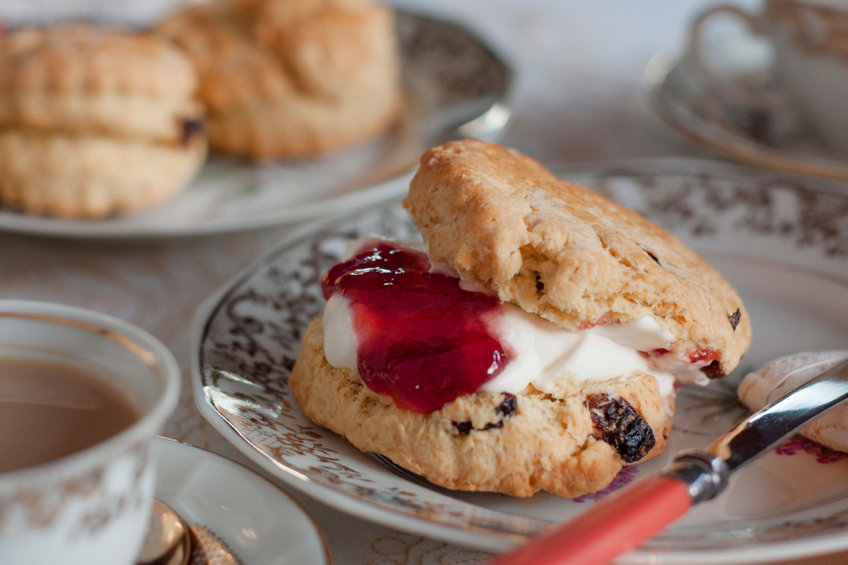
White Cottage Tea Room
Accommodations
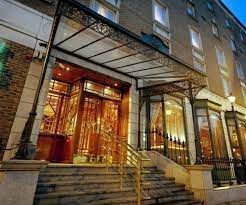
2 Nights
4-Star City Center Luxury Hotel4-Star City Center Luxury Hotel
Check in policies:
Check-in time is after 4:00pm on your day of arrival. Check-out time is before 11:00am.
The guest car park is situated on Fenian Street, a 3-minute walk from the hotel. There is an overnight rate of €18 for guests per 24 hours stayed in the car park. The hourly fee before and after those times is €4 per hour. You will need a code to access this car park which can be obtained by telephone or on reception as you check in.
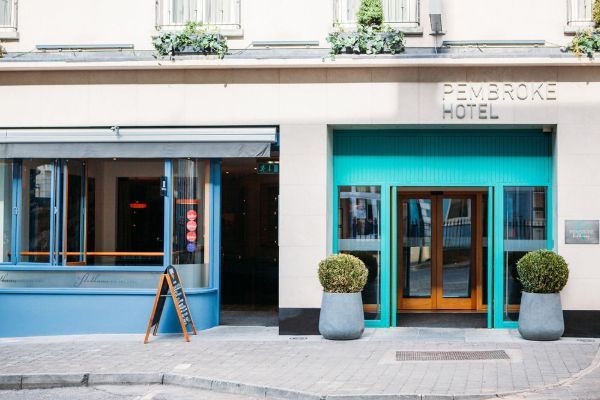
1 Night
4-Star Elegant City Center Hotel4-Star Elegant City Center Hotel
- Fully Air Conditioned
- Flat Screen TV
- Internet Access
- Tea & Coffee making facilities
- Trouser Press, Iron & Ironing Board
- Hairdryer
- Quality Bathroom Products
2 Nights
Preferred Luxury HotelPreferred Luxury Hotel

1 Night
18th Century Country House in the Burren18th Century Country House in the Burren
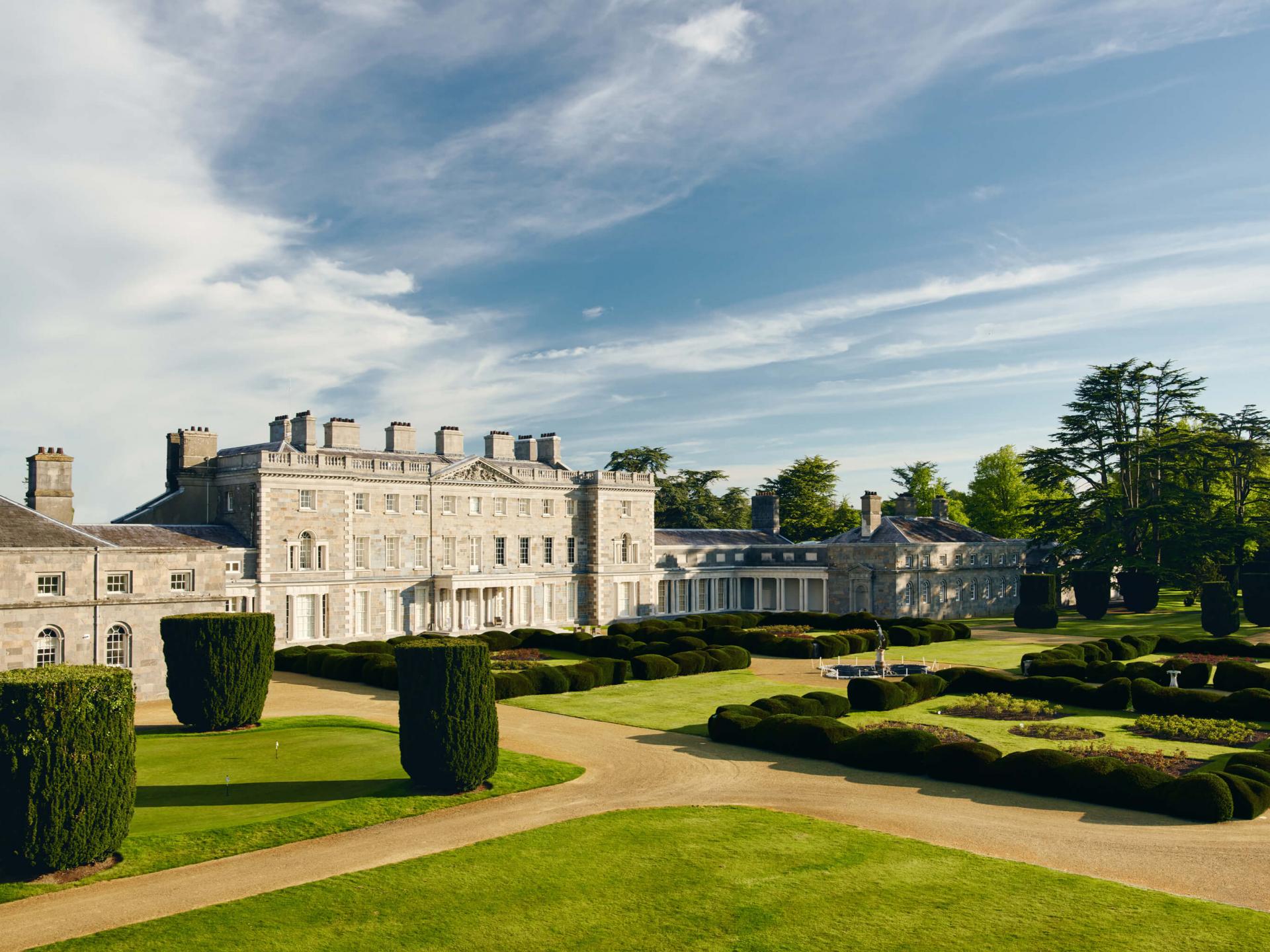
1 Night
Scenic Luxury HotelScenic Luxury Hotel
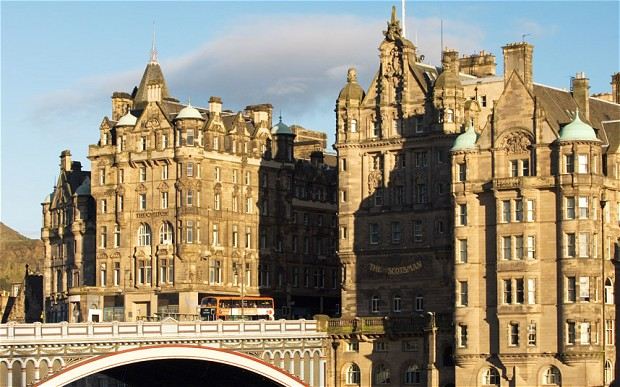
2 Nights
Historic Victorian 4-Star HotelHistoric Victorian 4-Star Hotel
- Complimentary Wi-Fi Internet Access
- Flat-Screen Satellite TV
- DVD Player
- Egyptian Cotton Linens
- Complimentary Tea, Coffee and Scottish Shortbread
- Complimentary Shoe Shine on request
- Evening Turndown Service
- Complimentary Scotsman Mineral Water
- Complimentary Scotsman Newspaper on request
- White Company Luxury Bathroom Toiletries
- Heated Towel Rail and Non-Steam Mirror
- Edinburgh Monopoly Board Game
- Hairdryer
- Personal Safe
- Bathrobe and slippers
- Trouser press, Iron and Ironing board
- Privacy Hatches (to avoid room service intrusion)
- 24-Hour Room Service
- Mini-Bar
- Scotsman Umbrella
- Access to the Scotsman Spa and Health Club
- Use of the Hotel's Vermillion Lounge to relax and unwind
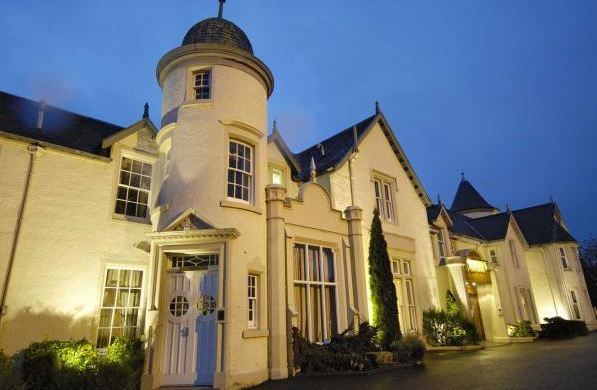
2 Nights
4-Star Landmark Luxury4-Star Landmark Luxury
The beautiful Kingsmills Hotel, set within four acres of manicured grounds, impeccably blends historic tradition, contemporary design and comfortable accommodation. Originally built in 1785 and renovated in 2009, the hotel is situated 1 mile from Inverness city centre and in close proximity to Loch Ness, Caledonian Canal and Culloden Battlefield. Many of the spacious rooms at Kingsmills Hotel have lovely garden views and are decorated to the highest of standards. The exclusive Kingsclub and Spa is authentically indulgent, featuring a sauna, steam room, spa tub and gym as well as a hair salon.
All Guestrooms Feature:
- Individual air conditioning
- Paid Wi-Fi in rooms
- LCD TV
- Movies (Pay Per View)
- Patio
- Separate sitting area
- Dressing area
- Carpeted floor
- Parquet floor
- In-room safe
- In-room desk
- Rollaway Beds
- Mini-Bar
- Trouser Press
- Tea & Coffee Facilities
- Direct dial telephone
- Separate tub & shower
- Bathtub
- Toilet
- In-room sink
- Grab Bars in Bathroom
- Hair dryer
- Room toiletries
- Emergency cord in bathroom
- Premium bedding
- AM/FM Alarm Clock
- Cribs Available
The Conservatory Restaurant
The Conservatory restaurant at The Kingsmills is an impressive setting for any occasion, whether it’s a relaxed lunch with friends, a business meeting or a romantic dinner for two. The Conservatory is flooded with refreshing natural light, creating a warm and calming atmosphere. No matter when you opt to visit, you can experience a fresh and unpretentious approach to Scottish cuisine.
The Inglis Restaurant
The splendid Inglis Restaurant, nestled within the historic 18th Century building of The Kingsmills Hotel, is a lovely place to relish in an intimate dinner and enjoy fond recollections of your day's adventures with friends or family. The menu features the freshest local produce from Inverness and the Scottish Highlands, all coming together to create an unforgettable dining experience.
Inverness, Scotland
On The Map: Inverness is located on Scotland's central northern coast. The town is accessed via the A9 road from the southeast (Cairngorms National Park), A82 from the southwest (Loch Ness) , and A96 from the northeast (Speyside, Whisky Country)
Inverness is the true capital of the Highlands, and with 50,000 people, it is one of Scotland’s fastest growing cities. It is also one of the Highland’s oldest settlements. All roads still lead to the Highland’s center, Inverness. It feels like a compact town, but it has the bustle and air of a lovely city. Let your imagination run wild, and take a ghost tour led by an 18th century ghost, complete with period costume. Expect to hear tales of the city’s blood-chilling past, including ghosts, witches, murders, and spells! Stroll along the River Ness, or cruise on the Moray Firth, searching out bottlenose dolphins. It is very peaceful, especially if you’ve just been ghost-hunting... The River Ness flows through Inverness, and salmon fishermen come during the summer, even where the river runs right through the city’s center. High above the city is Inverness Castle, a unique Victorian built of red sandstone. Just below the castle is the museum and Art Gallery which runs exhibitions and workshops for kids. The main shopping area fans out from there in three directions, and includes a lively gathering place where pipers and other musicians get together and make music.
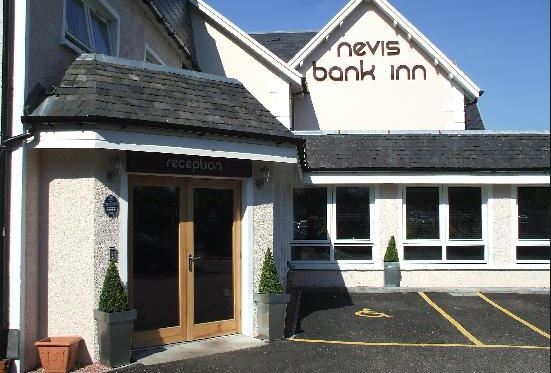
2 Nights
4-Star Traditional Riverside Hotel4-Star Traditional Riverside Hotel
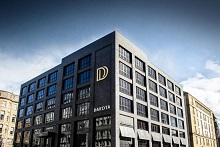
1 Night
Stylish Modern HotelStylish Modern Hotel
Check in policies:
Check-in time is after 3:00pm on your day of arrival. Check-out time is before 11:00am.
Validated car parking is available from £15 per day at Cambridge Street and Charing Cross car parks. Both car parks are within 10 minutes walk of the hotel. On-street parking is available around the hotel for £4 per hour.
Transportation and Guides
- Automatic Rental Car in Ireland & Scotland
Meals Included
- 14 Full, Sumptuous Irish & Scottish Breakfasts
Points of Interest
- Marvel at 6th Century Glendalough & Medieval Kilkenny
- Explore Stunning Scenery in County Kerry
- The Rock of Cashel & Adare Heritage Village
- The Cliffs of Moher & Globally Unique Burren Region
- Explore The Breathtaking Scottish Highlands
- Visit Scenic Loch Lomond & Mysterious Loch Ness
- Fascinating History & Scenic Beauty at Glencoe & Glenfinnan
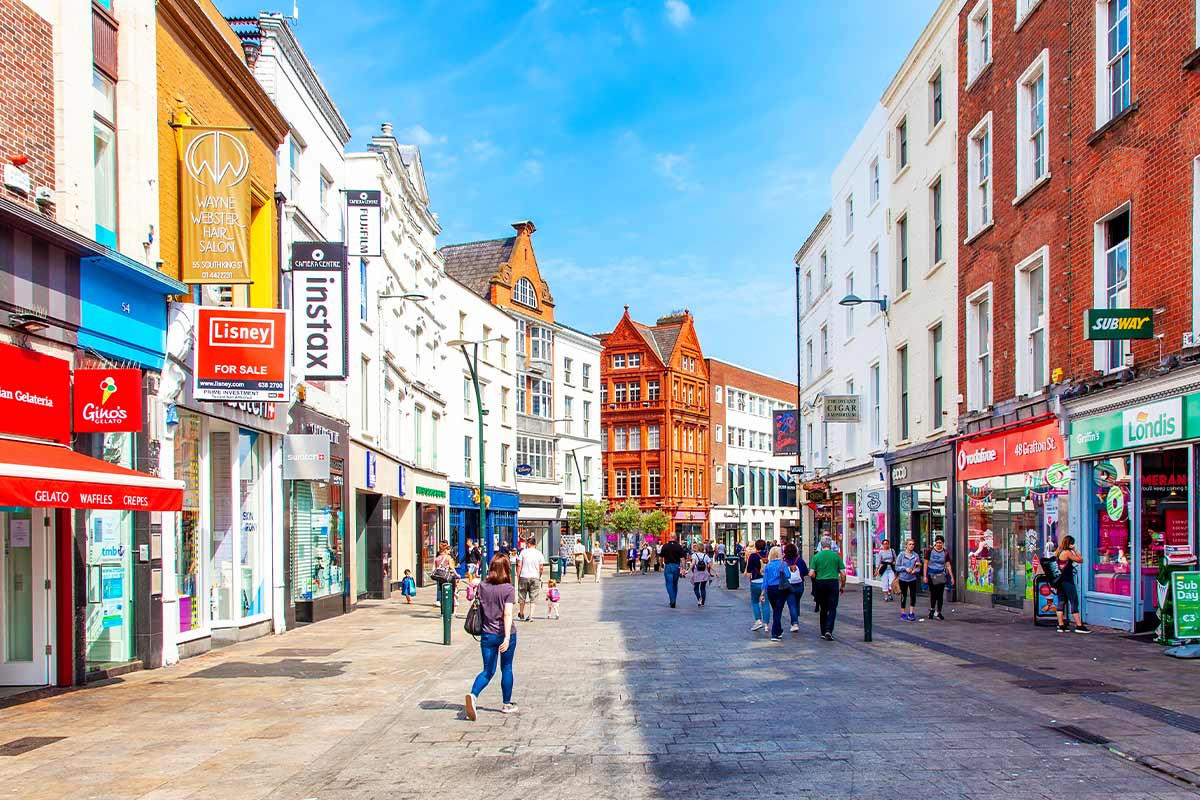
Grafton Street, County Dublin
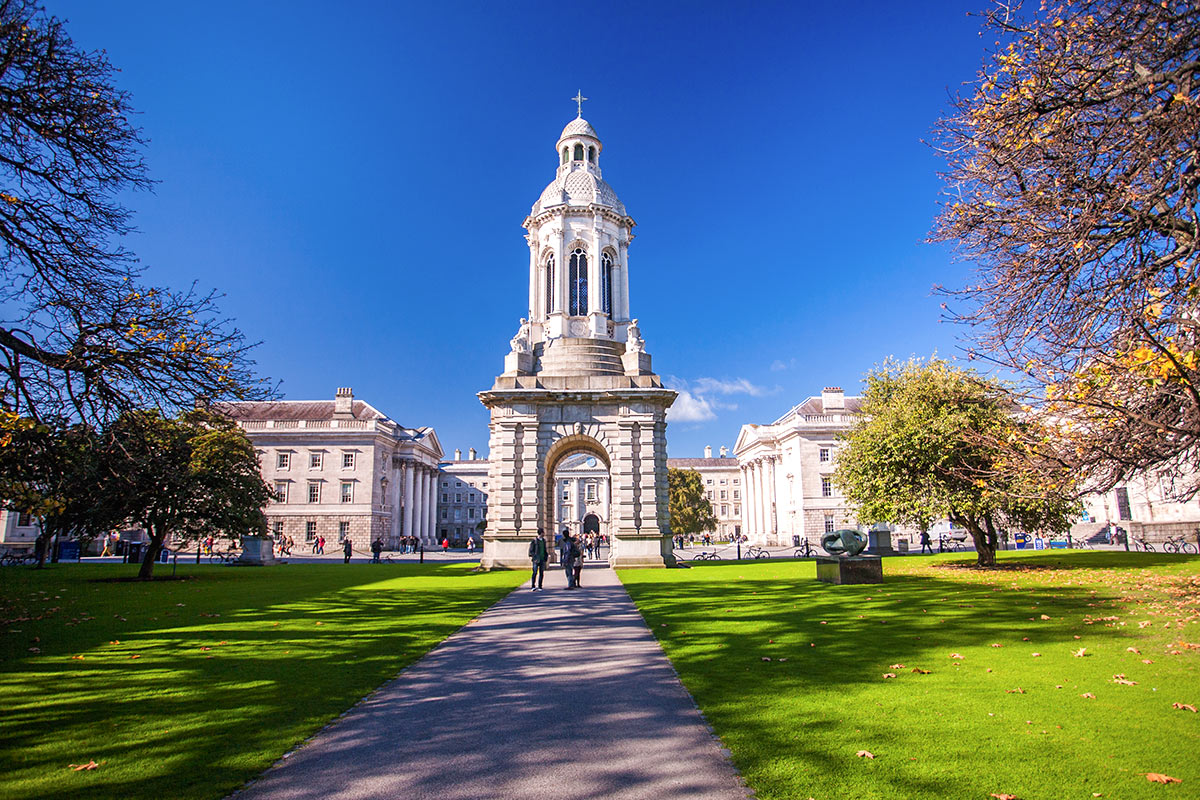
Trinity College, County Dublin
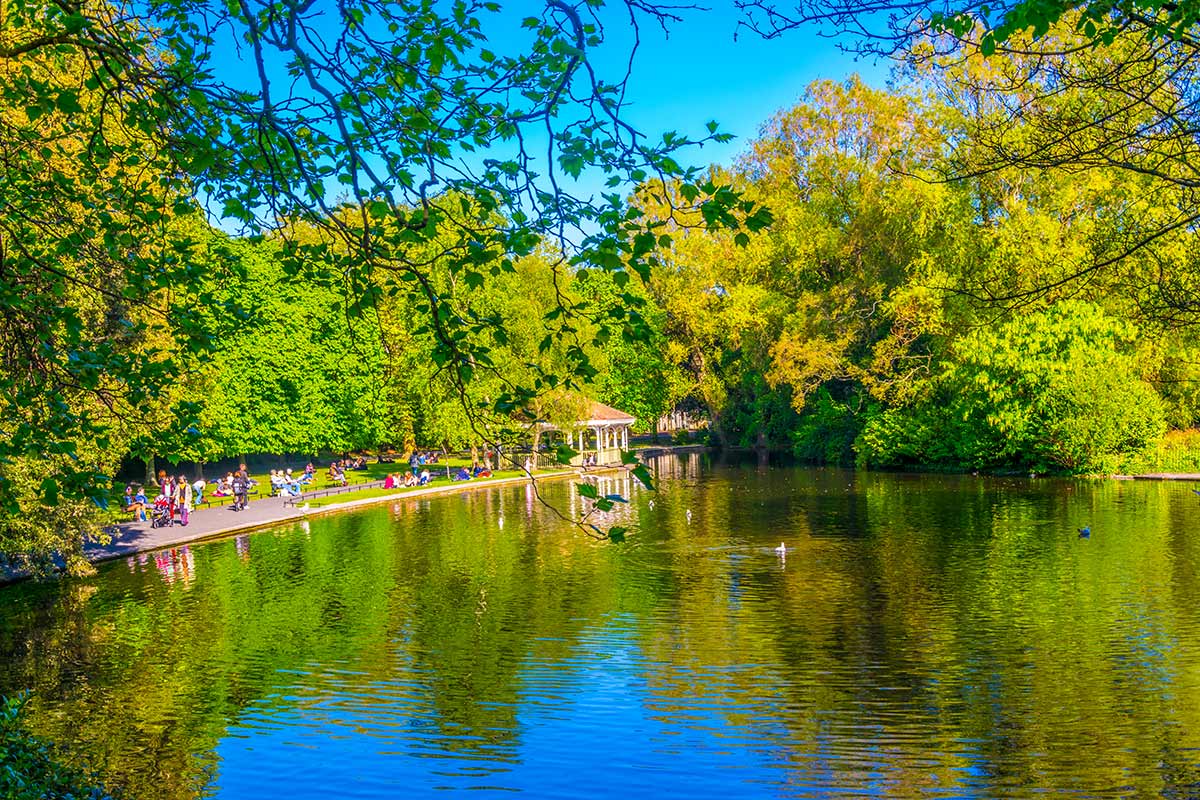
St Stephen's Green, County Dublin
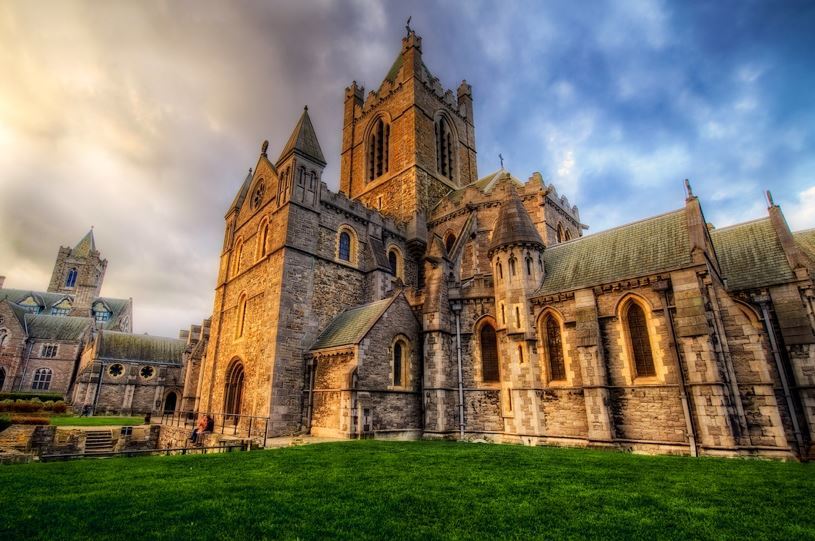
Christ Church Cathedral, County Dublin

Dublin, County Dublin
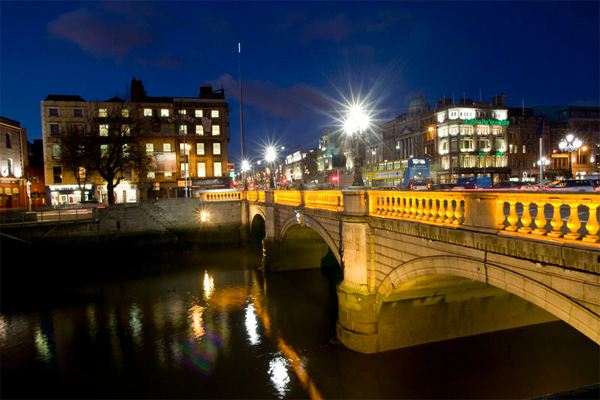
O'Connell Street, County Dublin
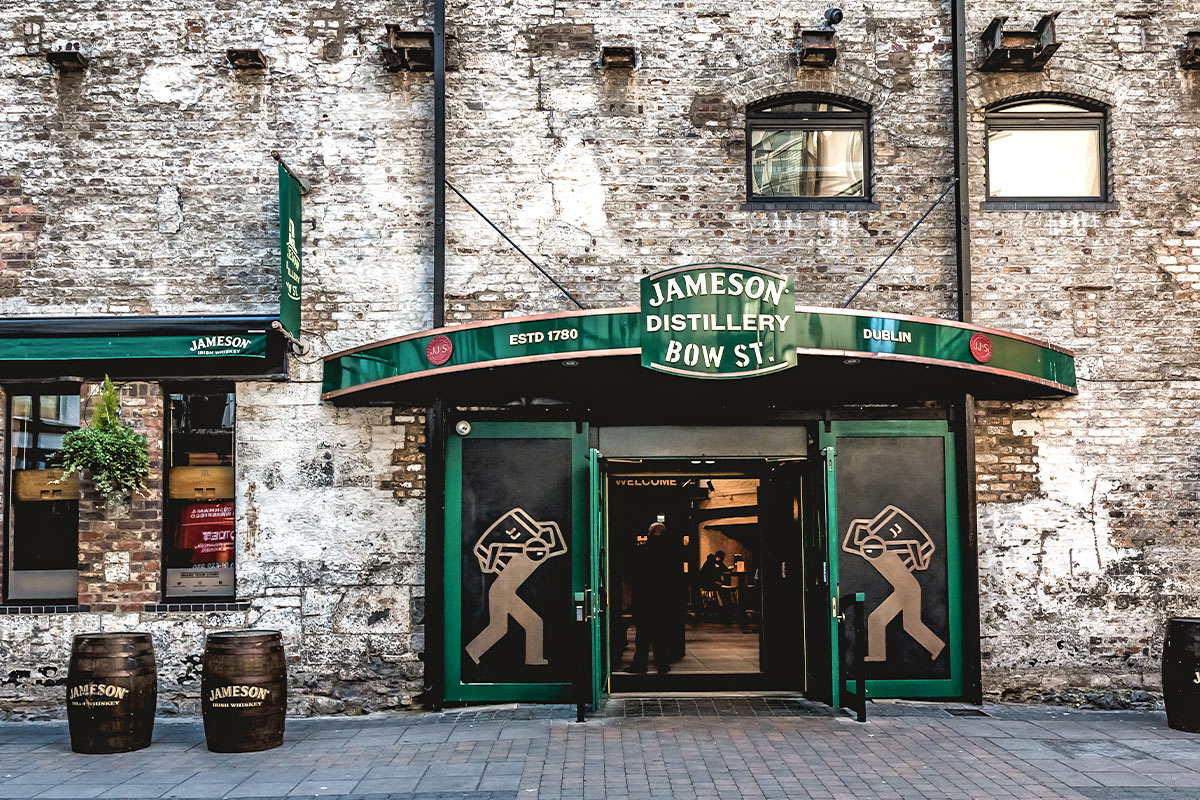
Old Jameson Distillery, County Dublin
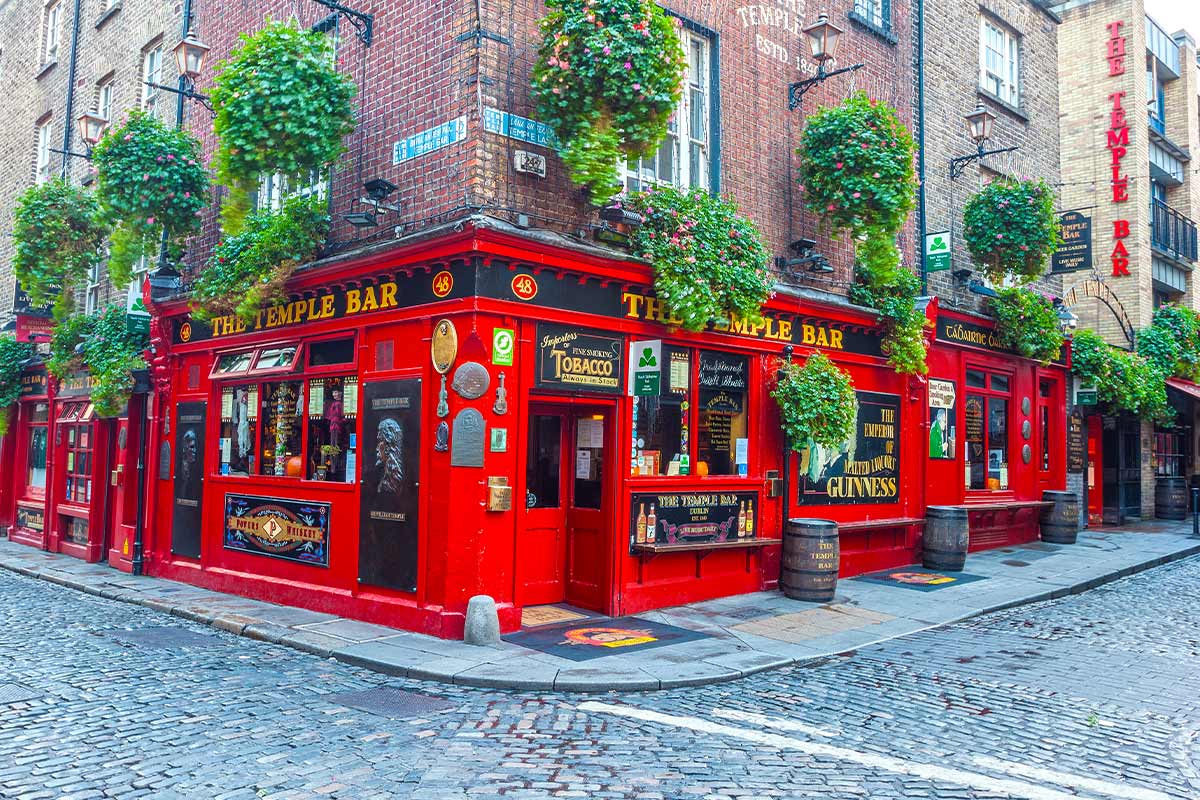
Temple Bar, County Dublin
- Day 1
Dublin, County Dublin
- Day 2
Dublin, County Dublin
- Day 3
Kilkenny, County Kilkenny
- Day 4
Killarney, County Kerry
- Day 5
Killarney, County Kerry
- Day 6
Lisdoonvarna, County Clare
- Day 7
Maynooth, County Kildare
- Day 8
Edinburgh, Central Scotland
- Day 9
Edinburgh, Central Scotland
- Day 10
Inverness, Highlands
- Day 11
Inverness, Highlands
- Day 12
Fort William, Highlands
- Day 13
Fort William, Highlands
- Day 14
Glasgow, Central Scotland
- Day 15
Depart
 Day 1
Day 1
Accommodation
4-Star City Center Luxury Hotel - Dublin, County Dublin

Check in policies:
Check-in time is after 4:00pm on your day of arrival. Check-out time is before 11:00am.
The guest car park is situated on Fenian Street, a 3-minute walk from the hotel. There is an overnight rate of €18 for guests per 24 hours stayed in the car park. The hourly fee before and after those times is €4 per hour. You will need a code to access this car park which can be obtained by telephone or on reception as you check in.
Included Unique Activities
Meet & Greet Private Airport Transfer - Dublin

Your tour includes a luxurious private transfer from Dublin Airport to your Downtown Hotel. Once you have your luggage, proceed through to the Arrivals Hall, and look for your driver. He or she will be holding an iPad with your name clearly on it. They will quickly escort you to your ride, taking you to your Dublin City Center Hotel. There is no searching for shuttles, cabs, or trying to decide which route to take. This is the perfect start to a well-deserved, relaxing vacation. Your Irish adventure begins with Authentic Vacations’ 5-star customer service!
Arrive at
Arrive at Dublin Airport, County Dublin
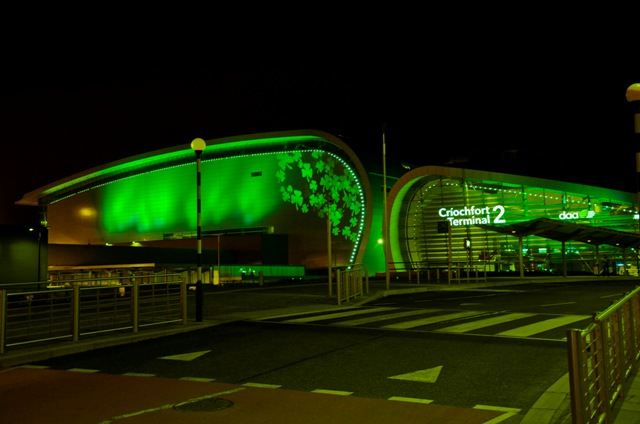
Arrive at Dublin Airport after your overnight flight if you are coming from the U.S. or Canada.
Dublin is Ireland's main airport - located just north of Dublin City. If you are heading downtown, it takes approximately 20 to 30 minutes from the airport, depending on traffic. There are 2 terminals at Dublin Airport, the second of which opened to air traffic in November 2010. Most flights from the U.S. (on Aer Lingus, Delta, United, US Airways & American Airlines) arrive into Terminal 2.
Suggested Sightseeing
Trinity College, County Dublin

On The Map: Trinity College is located in the heart of Dublin City. Just south of the River Liffey, the campus grounds are bordered by Grafton, College, Pearse, Nassau & Leinster Streets.
Time spent in Dublin would not be complete without a visit to Trinity College. Founded in 1592 by Queen Elizabeth 1st, it is one of the oldest universities in the British Isles, and the very oldest in Ireland. Standing on a self contained site in the very heart of Dublin, the College itself covers some 35 acres of cobbled squares and green spaces surrounded by buildings which represent the accumulated architectural riches of nearly three centuries. Although Trinity offers much of interest to the visitor, the crown jewel is without doubt the Book of Kells. The Book is an 'illuminated manuscript', globally celebrated for its lavish decoration. The manuscript contains the four Gospels in Latin based on a Vulgate text, written on vellum (prepared calfskin), in a bold and expert version of the script known as 'insular majuscule'. Written in the 9th century, it has been on display in the Old Library at Trinity College Dublin from the mid-19th century, and attracts over 500,000 visitors a year.
Grafton Street, County Dublin

Location: Grafton Street runs from Saint Stephen's Green in the south to College Green in the north
Grafton Street is without doubt Ireland's premier shopping street - in terms of retail rent, it's the fifth most expensive in the world! With beautiful historic buildings housing iconic Irish businesses such as Brown Thomas, Weir & Sons and Bewley’s Grafton Street Café, Grafton Street offers an experience that cannot be found elsewhere in the country. Since the 1980s, the street has been mostly pedestrianized, with the exception of a short stretch that runs between Nassau Street and College Green and contains the 18th century Trinity College Provost's House, home to the head of the college. If shopping's not your thing, Grafton Street is still worth checking out. It's a bustling, atmospheric spot, and high quality street performers including musicians, poets and mime-artists commonly perform to the shopping crowds.
St Stephen's Green, County Dublin

On The Map: St Stephen's Green is located in the heart of Dublin City, at the southern end of bustling Grafton Street - the city's premier shopping street. The famous Stephen's Green Shopping Centre is adjacent to the northwestern corner of the Green itself.
Stephen's Green is Ireland's best known Victorian public park. Originally enclosed by a wall in 1664, access to the 22 acre Green was restricted to local residents until 1880. The Green has been maintained in the original Victorian layout with extensive perimeter tree and shrub planting, as well as spectacular spring and summer Victorian bedding. The herbaceous border also provides colour from early spring to late autumn. Sanctuary from inclement weather can be obtained in the Victorian lakeside shelter or in the Victorian Swiss shelters in the center of the park. Over 3.5 km of pathways are accessible for all users. The waterfall and Pulham rock work on the western side of the green are worth of a visit, likewise the ornamental lake which provides a home for waterfowl and a garden for the visually impaired. A number of sculptures are located throughout the green. A children's playground is a popular attraction of the park. Lunchtime concerts are performed during the summer months.
Christ Church Cathedral, County Dublin

Christ Church Cathedral is a leading visitor attraction and has been a place of pilgrimage for almost 1,000 years. Located in the heart of Medieval Dublin and renowned for its beauty, architecture and exquisite floor tiles, Christ Church Cathedral was founded in 1030 by Sitric, King of the Dublin Norsemen. In 1152 it was incorporated into the Irish Church and eventually led by the famous Archbishop and patron saint of Dublin, Laurence O’Toole. The cathedral is home to the famous 12th-century crypt, one of the oldest and largest in Britain and Ireland. The restored crypt houses the important Treasures of Christ Church exhibition which features manuscripts and artefacts that give visitors some impression of nearly one thousand years of worship in the cathedral and nearby churches.The Treasury also plays host to a rare 14th century copy of the Magna Carta Hiberniae.
Overnight Location
Dublin, County Dublin

On the Map: Dublin, Ireland's Capital City is located on the east coast of the country, and is well served by infrastructure linking it to all parts of the Emerald Isle.
Dublin is a lively cosmopolitan city, filled with personality, pizzazz, and culture. You might spend time strolling the streets, soaking up the atmosphere, relaxing in cafes and pubs, or you could check out a world of historical, literary, and musical delights. A return visit to the Book of Kells, Phoenix Park (twice the size of Central Park), Georgian Dublin, Stephen’s Green, Dublin Castle, the National Museum, Kilmainham Gaol, and the Hugh Lane Municipal Art gallery are all possibilities. Ramble through Grafton Street, a shopper’s paradise, or simply relax and remember this most wonderful tour of the Emerald Isle.
 Day 2
Day 2
Accommodation
4-Star City Center Luxury Hotel - Dublin, County Dublin

Check in policies:
Check-in time is after 4:00pm on your day of arrival. Check-out time is before 11:00am.
The guest car park is situated on Fenian Street, a 3-minute walk from the hotel. There is an overnight rate of €18 for guests per 24 hours stayed in the car park. The hourly fee before and after those times is €4 per hour. You will need a code to access this car park which can be obtained by telephone or on reception as you check in.
Included Unique Activities
Musical Pub Crawl

The Traditional Irish Musical Pub Crawl is led by two professional musicians who perform tunes and songs while telling the story of Irish Music and its influences on contemporary world music. The Crawl is best described as a moving concert, at which everyone is guaranteed a seat in the privately booked pubs. The Crawl is a highly entertaining and informative evening of music and song. The musicians explain the history of Irish music and share their personal stories of the how Irish people interact with the music as its played today. You will visit famous pubs and bars in the Temple Bar area. All pubs are privately booked, with private bar and are in close proximity to one another. Tickets are for the tour only, no beverages or food are included. Drinks range from approximately €4-€12.
*Note: Children under 18 years of age may not attend the Musical Pub Crawl*
Guinness Storehouse Tour

Prepare yourself for an unforgettable Irish welcome, delving deep into the wonder of world-famous Guinness! The brewery is located in the heart of Dublin at historic St. James Gate. Originally a small brewery, it is now a 7-story visitor experience that brings the history, story, and taste of the Emerald Isle’s iconic brew to life.
Imagine the world’s largest pint glass (Guinness did start the Guinness Book of World Records, after all) rising to the top of the building. Amazing. The dramatic story begins 250-years-ago and incorporates a family legacy handed down through generations. You’ll end your time here at the Gravity Bar, enjoying a complimentary pint of Guinness. Relax and enjoy spectacular views of Dublin. Plan to spend 1 ½ to 2 hours here.
Suggested Sightseeing
Dublin Castle, County Dublin
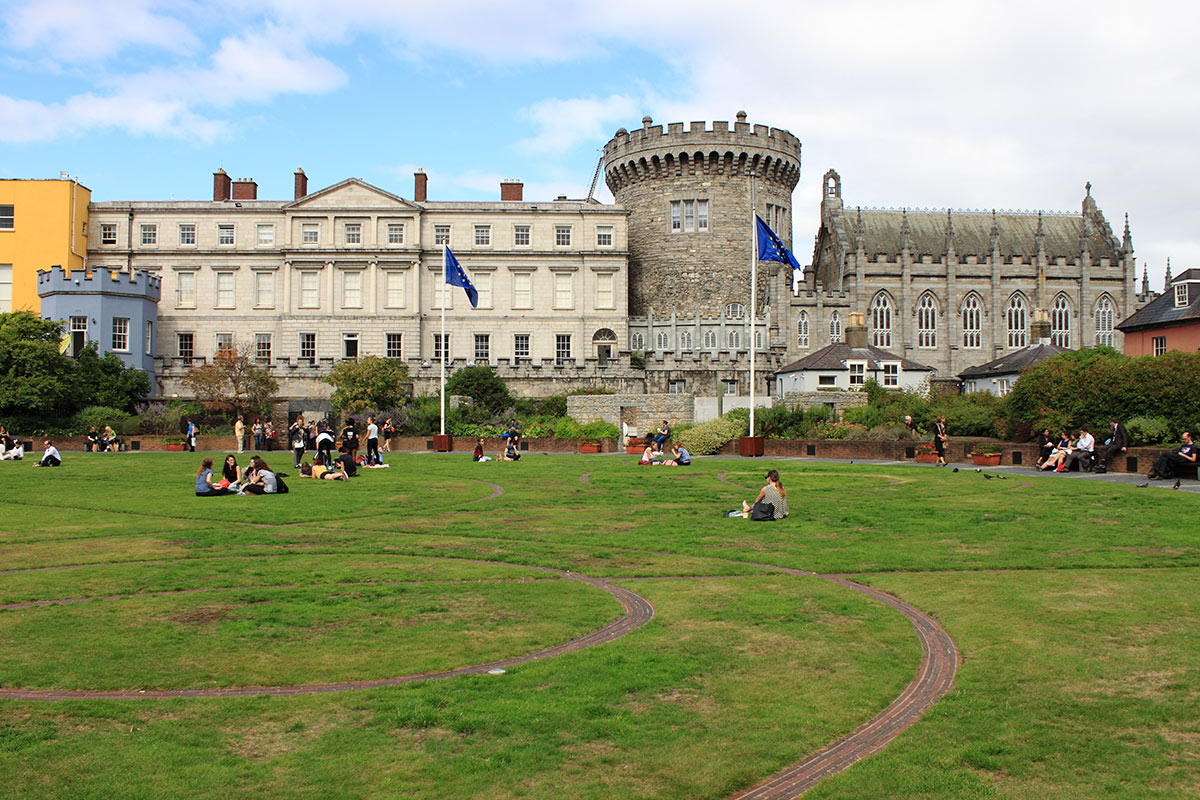
Since its foundation in 1204, Dublin Castle has been at the heart of the history and evolution of Dublin. Today, spanning an area of over 44,000 square meters (11 acres), the site contains 2 museums, 2 cafés, an international conference centre, 2 gardens, Government Buildings and the State Apartments (the most important state rooms in the country). The grounds of the Castle are free to explore, as is the Chapel Royal, the Chester Beatty Library, the Garda Museum and the Revenue Museum. Access to the State Apartments is by guided tour only and tickets may be purchased from the Apartments in the Upper Castle Yard.
Dublin Museums, County Dublin
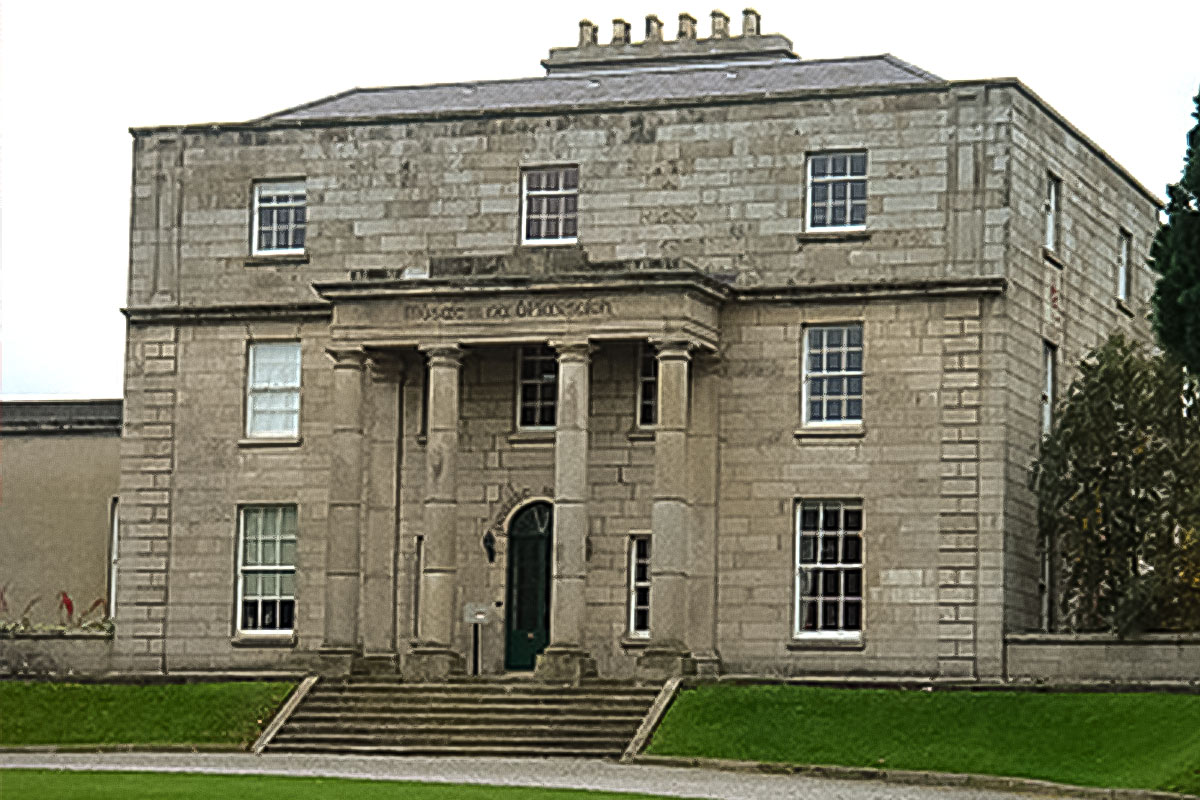
Dublin has long been recognized as a center of art & culture. The city is literally awash with interesting museums and galleries of all types and sizes. It's impossible to make note of them all, but three of the best are: The Chester Beatty Library: Alfred Chester Beatty, a New Yorker donated a fantastic collection of books to the city of Dublin. Highlights include papyrus scripts, valuable copies of the Koran, Buddhist & Far Eastern literature, as well as early mediaeval manuscripts. National Museum of Ireland - Archaeology: Enter this museum and be transported back in time to almost 7000BC! Gold and other treasures recount a varied Irish history through Christian and pre-Christian times. A range of exhibitions also present artifacts from many other cultures and regions. National Gallery: Here you can admire European works of art from the late Middle Ages to the end of the 19th century. As well as Irish artists, the Gallery also boasts works by Angelico, Goya, Gainsborough & Reynolds, to name but a few.
Old Jameson Distillery, County Dublin

On The Map: The Old Jameson Distillery is located in the Smithfield area of Dublin City. Walking from Trinity College (approx 20 minutes), head west on Dame Street to Lord Edward Street to Christchurch Place. Carry on past Christchurch Cathedral and take the next right onto Bridge Street. Head straight over Merchants Quay and Fr. Mathew bridge across Arran Quay. Walk up Church Street past St. Michans Cathedral and then take the next left onto May Lane /Bow Street. Alternately, the Distillery is Stop 20 on the 'hop-on, hop-off' Dublin Bus tour.
Set in the heart of Ireland’s thriving capital city, Dublin, The Old Jameson Distillery captures the imagination and the spirit of Ireland. Originally built in 1780, this Distillery was once considered one of the largest and finest Distilleries in the world. Tours operate 7 days a week all year, except selected dates at Christmas. The journey begins with an audio visual presentation. Expert guides then lead you through the fascinating story of Jameson, one of the world’s most famous whiskies. Follow the path through malting, milling, mashing, fermenting, distilling and maturing. The journey is completed with a visit to the Jameson Discovery Bar where you can enjoy the ultimate whiskey tasting experience - a complimentary glass of Jameson and mixer plus a chance for selected volunteers to become a "Qualified Irish Whiskey Taster". After your tour, browse in the gift shop or lunch in the restaurant or bar and soak up the unique atmosphere.
Dublin, County Dublin

On the Map: Dublin, Ireland's Capital City is located on the east coast of the country, and is well served by infrastructure linking it to all parts of the Emerald Isle.
Dublin is a lively cosmopolitan city, filled with personality, pizzazz, and culture. You might spend time strolling the streets, soaking up the atmosphere, relaxing in cafes and pubs, or you could check out a world of historical, literary, and musical delights. A return visit to the Book of Kells, Phoenix Park (twice the size of Central Park), Georgian Dublin, Stephen’s Green, Dublin Castle, the National Museum, Kilmainham Gaol, and the Hugh Lane Municipal Art gallery are all possibilities. Ramble through Grafton Street, a shopper’s paradise, or simply relax and remember this most wonderful tour of the Emerald Isle.
Temple Bar, County Dublin

Location: Temple Bar lies in the heart of Dublin City. Located on the south bank of the River Liffey, and just west of Trinity College and Grafton Street.
The lively and vibrant Temple Bar District - Dublin's Cultural Quarter, is well worth a visit. Best known for being Dublin’s major nightlife center, Temple Bar comes alive after dark, with many pubs, restaurants and nightclubs to choose from. For those visiting during the day, the area boasts a timeless charm, with narrow cobbled streets and a plethora of cultural organizations, such as the Irish Film Centre & Project Arts Centre. There are also a variety of small galleries and stores - perfect for a day of shopping. While Temple Bar after dark might not be for everyone, the area is the perfect spot to spend a sunny afternoon.
O'Connell Street, County Dublin

On The Map: Located in the heart of Dublin city, the street's layout is simple but elegant. Within O'Connell Street and it's side streets you'll find endless historical monuments, dining choices and shopping districts, both traditional and high street. O'Connell Street has often been centre-stage in Irish history, attracting the city's most prominent monuments and public art through the centuries, and formed the backdrop to one of the 1913 Dublin Lockout gatherings, the 1916 Easter Rising, the Irish Civil War of 1922, the destruction of the Nelson Pillar in 1966, and many public celebrations, protests and demonstrations through the years – a role it continues to play to this day. State funeral corteges have often passed the GPO on their way to Glasnevin Cemetery, while today the street is used as the main route of the annual St. Patrick's Day Parade, and as the setting for the 1916 Commemoration every Easter Sunday. It also serves as a major bus route artery through the city centre.
Attractions:
General Post Office (GPO), Statue of Daniel O'Connell, The Spire, Staute of James Stewart Parnell, Clery's Department Store, Major Shopping Districts.
 Day 3
Day 3
Accommodation
4-Star Elegant City Center Hotel - Kilkenny, County Kilkenny

Check in policies:
Check-in time is after 4:00pm on your day of arrival. Check-out time is before 12:00noon.
We have complimentary private parking for guests, please set down in front of hotel and a team member will guide you.
Included Unique Activities
Kilkenny Castle

Kilkenny Castle is dramatically perched on high ground, commanding a view, and a crossing, of the River Nore. (The River Nore winds through Kilkenny—explore her shoreline.) The medieval castle dominates the “High Town” of Kilkenny City. Over a period of eight centuries, many additions and alterations have been made. The Castle is now a complex structure of various architectural styles.
The original Anglo-Norman Castle was built for the 4th Earl of Pembroke, Willliam Marshall, at the beginning of the 13th century. James Butler, 3rd Earl of Ormond, purchased the Castle in 1391. It stayed in the powerful Butler family for 600 years until Arthur, 6th Marquess of Ormonde, quite generously presented it to the people of Kilkenny in 1967 for £50. Various programs of archaeological excavation, conservation, and restoration are carried out here.
Suggested Sightseeing
Kilkenny Castle, County Kilkenny
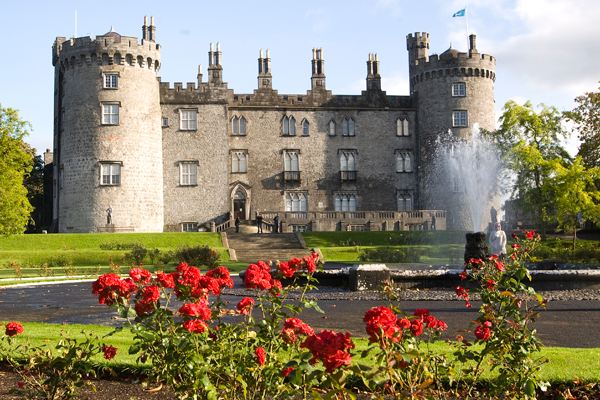
On The Map: Kilkenny Castle is situated in the heart of mediaeval Kilkenny City, in the southeast midlands of Ireland.
Kilkenny Castle stands dramatically on a strategic height, commanding a crossing of the River Nore and dominating the 'High Town' of Kilkenny City. Over the eight centuries of its existence, many additions and alterations have been made to the fabric of the building, making Kilkenny Castle today a complex structure of various architectural styles. The original castle was constructed in the early 13th century for the 4th Earl of Pembroke. The Castle later became the principal Irish residence of the powerful Butler family, and remained so for almost 600 years from 1391 to 1967. The Butler ownership ended when Arthur, 6th Marquess of Ormonde (1893-1971), presented it to the people of Kilkenny in return for a token payment of £50. Due to major restoration works, the central block now includes a library, drawing room, and bedrooms decorated in 1830's splendour, as well as the beautiful Long Gallery. A suite of former servant's rooms is the Butler Art Gallery, which mounts frequently changing exhibitions of contemporary art. The Parade Tower is the Castle's conference venue.
Kilkenny, County Kilkenny

On the Map: Kilkenny City is located in County Kilkenny, in the southeast midlands of Ireland. Kilkenny is well-served by a good network of roads - the M9/N10 from Dublin (to the northeast) and N9/N10 from Waterford City (to the south). Kilkenny, or the Marble City as it is known, is one of Ireland's oldest towns, and proud of it. Its array of ancient buildings is unrivalled. It is renowned for being a vibrant cultural center, devoted to the musical and visual arts. Its two most impressive landmarks are Kilkenny Castle, founded in 1172 and privately owned until 1967, and St. Canice's Cathedral. The current structure of the cathedral dates from the 13th century, though this is nowhere near the beginning of its story, which is rich in folklore and legend. There is no shortage of pubs to explore and enjoy in Kilkenny and during the summer the city is always full of life. The summer also sees the city host an Arts Festival and a very highly regarded Comedy Festival called the Cat Laughs.
Enroute Sightseeing
Powerscourt House and Gardens, County Wicklow
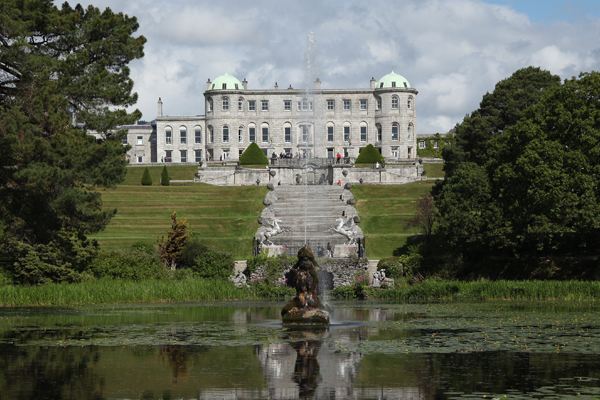
On the Map: Powerscourt House & Gardens is located in County Wicklow in the east of Ireland. Powerscourt is accessed via the R117 road, which intersects with the main M11/N11 approx. 30 kilometres south of Dublin City. One mile long and lined by over 2,000 beech trees, even the avenue leading to the Powerscourt House echoes the magnificence of the whole estate. In addition the 47 acres of gardens are remarkable for their grandeur of scale, at the same time combining great delicacy and refinement of detail. The house was gutted by fire in 1974 but recently has been reborn as an exceptional tourist destination. An exhibition brings to life the rich history of the estate, while the double height Georgian ballroom has been restored and hosts weddings and corporate events. The house is now home to the best of Irish design in gifts, clothes, and furniture in the Avoca Stores and the Interiors Gallery. You can also treat yourself to a dish from the Avoca Cookbook in the Terrace Cafe. Or you can visit the Powerscourt Distillery onsite as well. The gardens at Powerscourt, recently voted Number 3 in the entire world by National Geographic, were laid out in two main periods. When the house was rebuilt in the decade after 1731, the surrounding grounds were also remodelled. The design reflected the desire to create a garden which was part of the wider landscape. To the north formal tree plantations framed the vista from the house, while a walled garden, fish pond, cascades, grottos and terraces lay to the south. Walks wound through the wooded grounds and a fine tree-lined avenue was created.
Glendalough, County Wicklow
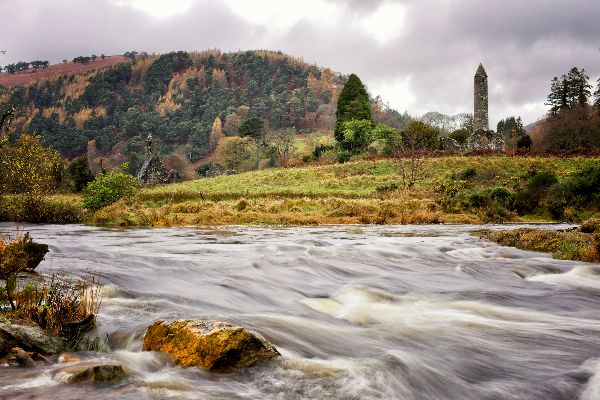
On the Map: Glendalough is located in County Wicklow, in the east of Ireland - just 1 hour south of Dublin City. Scenically nestled in the Wicklow Mountains, Glendalough is served by a network of small country roads. From the northeast (Dublin), travel on the R755/R756, from everywhere else, arrive from the west on the R756.
Glendalough ("The Glen of the Two Lakes"), is the site upon which St. Kevin founded a unique monastic settlement in the 6th century. Most of what remains of the settlement is in ruins but the Round Tower at Glendalough, built as a refuge from marauding Vikings, is over a 1000 years old and is remarkably well preserved. The site itself is set next to two clear water lakes beneath the sheer cliffs of a deep glacial valley. It is one of the most serene and beautiful places in all Ireland and it is easy to see why the monks picked it for a place of prayer and contemplation. There are a myriad of walking trails throughout the area making it a truly invigorating place to spend the day.
Overnight Location
Kilkenny, County Kilkenny

On the Map: Kilkenny City is located in County Kilkenny, in the southeast midlands of Ireland. Kilkenny is well-served by a good network of roads - the M9/N10 from Dublin (to the northeast) and N9/N10 from Waterford City (to the south). Kilkenny, or the Marble City as it is known, is one of Ireland's oldest towns, and proud of it. Its array of ancient buildings is unrivalled. It is renowned for being a vibrant cultural center, devoted to the musical and visual arts. Its two most impressive landmarks are Kilkenny Castle, founded in 1172 and privately owned until 1967, and St. Canice's Cathedral. The current structure of the cathedral dates from the 13th century, though this is nowhere near the beginning of its story, which is rich in folklore and legend. There is no shortage of pubs to explore and enjoy in Kilkenny and during the summer the city is always full of life. The summer also sees the city host an Arts Festival and a very highly regarded Comedy Festival called the Cat Laughs.
 Day 4
Day 4
Accommodation
Preferred Luxury Hotel - Killarney, County Kerry
Check in policies:
Check-in time is after 4:00pm on your day of arrival. Check-out time is before 12noon.
Free car parking is available on site.
Suggested Sightseeing
Muckross House and Gardens, County Kerry
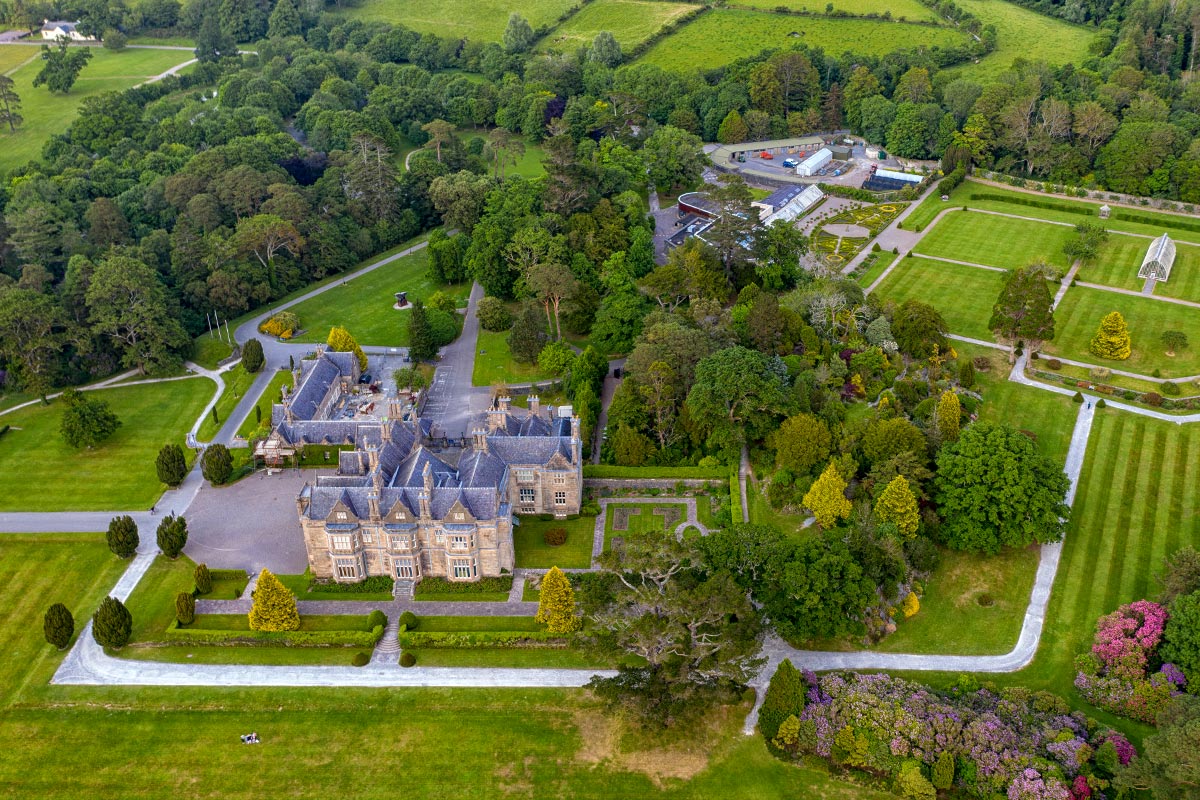
On The Map: Muckross House is located just 6 kilometres south of Killarney, County Kerry, in the southwest of Ireland. From Killarney, take the N71 south for Kenmare. The only vehicle entrance is located approximately 1km beyond the Muckross Park Hotel - on the right. Muckross House, set close to the shores of Muckross Lake & amidst the beautiful scenery of Killarney National Park, was built for Henry Arthur Herbert and his wife, the watercolourist Mary Balfour Herbert. William Burn, the well-known Scottish architect, was the designer. Building commenced in 1839 and was completed in 1843. Today the principal rooms are furnished in period style and portray the elegant lifestyle of the 19th century land-owning class. While in the basement, one can imagine the busy bustle of the servants as they went about their daily chores. During the 1850s, the Herberts undertook extensive garden works in preparation for Queen Victoria's visit in 1861. Between the months of April and July, Muckross Gardens are spectacularly adorned with the red and pink flowers of mature Rhododendrons. Other features include a Sunken Garden, Rock Garden and Stream Garden. An Arboretum, containing many trees from the Southern Hemisphere, was established in 1972. Muckross Traditional Farms are situated adjacent to Muckross House. These working farms recreate and portray the traditional farming methods, and way of life, of a typical local, rural community of the 1930s. The Walled Garden Centre incorporates the Garden Restaurant, Mucros Craft Shop and three Mucros Craft Workshops.
Killarney National Park, County Kerry
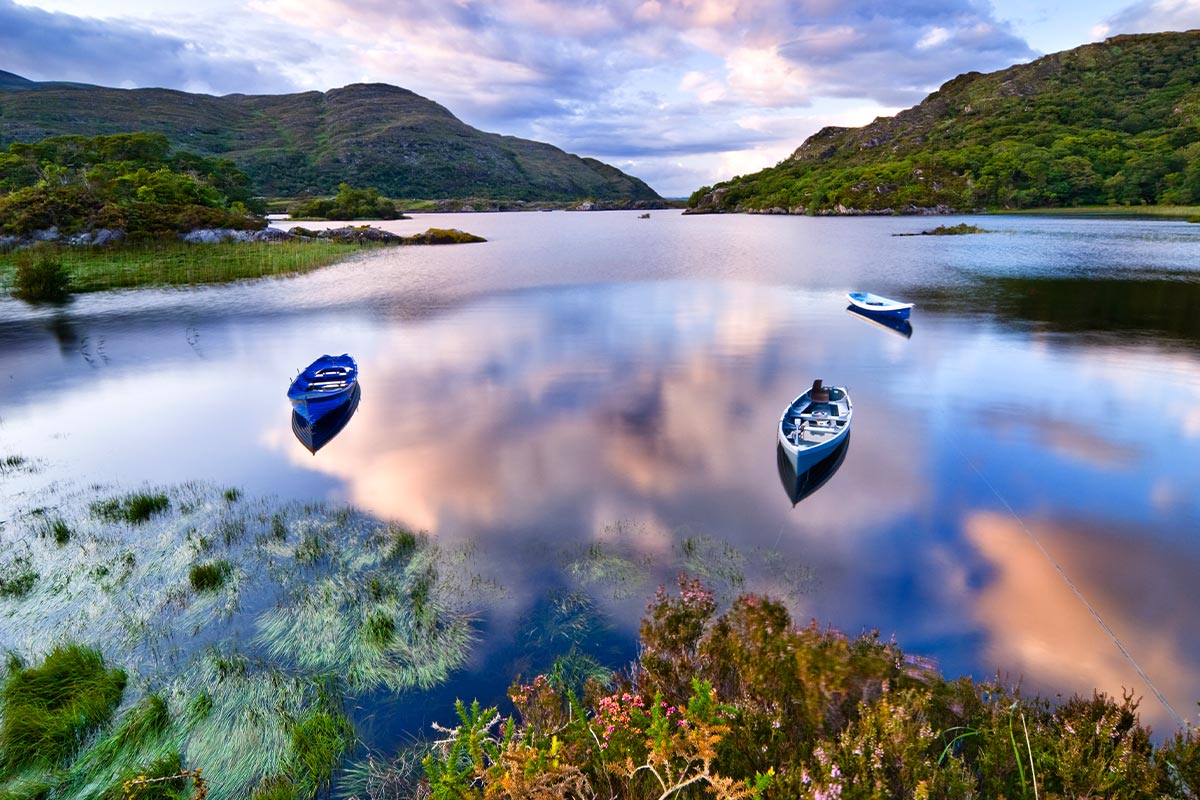
On the Map: Killarney is located in County Kerry in the southwest of Ireland. The town is reached via the N22 from Tralee/ Limerick (to the north) and the N22 from Cork City (to the southeast).
On the southwestern edge of Killarney Town lies an untamed, rugged & mountainous country. The area includes the McGillycuddy's Reeks, Ireland's highest mountain range. At the foot of these mountains nestle the world famous lakes of Killarney. Here, where the mountains sweep down to the lake shores, their lower slopes covered in woodlands, you'll discover the 26,000 acre Killarney National Park . The distinctive combination of mountains, lakes, woods and waterfalls under ever changing skies, lends the area a special scenic beauty. The Park contains many features of national and international importance such as the native oakwoods and yew woods, together with an abundance of evergreen trees and shrubs. A profusion of bryophytes and lichens thrive in the mild Killarney climate. The native red deer are unique in Ireland, with a presence in the country since the last Ice Age. At the heart of the National Park is Muckross House and Gardens. The house, a late 19th century mansion features period furnishings and artefacts and is a major visitor attraction in itself. Killarney National Park was designated as a Biosphere Reserve in 1981 by the United Nations Educational, Scientific and Cultural Organisation (UNESCO).
Enroute Sightseeing
Rock of Cashel, County Tipperary
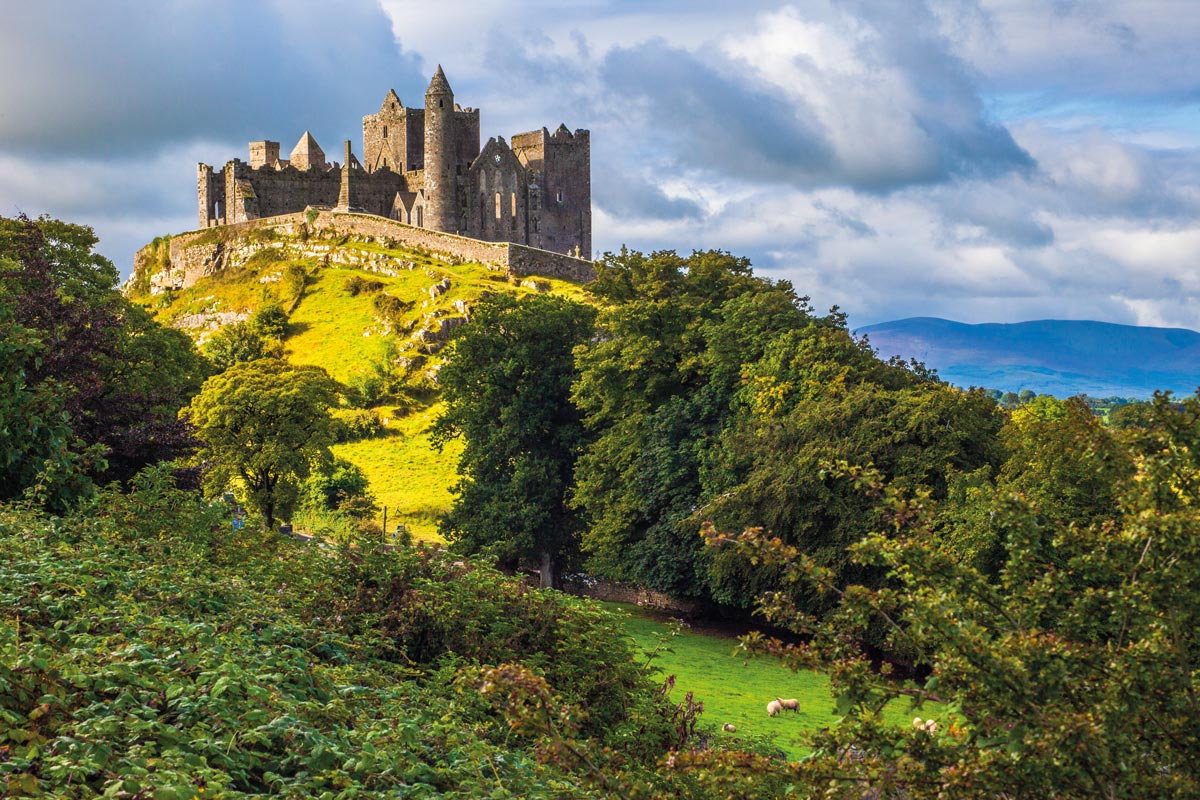
On the Map: Cashel is located in County Tipperary in the southern midlands of Ireland. The main M8 motorway connecting the major cities of Dublin (to the northeast) and Cork (to the southwest) passes right by the town.
The Rock of Cashel (Carraig Phádraig), more formally St. Patrick's Rock, is also known as Cashel of the Kings. One of the most visited sites in Ireland, The Rock is a spectacular group of medieval buildings set on a rocky outcrop of limestone, looming above the town of Cashel, County Tipperary. There is a 12th Century round tower, High Cross and Romanesque Chapel, 13th century Gothic cathedral, 15th century castle and the Hall of the Vicars. Long before the Norman invasion The Rock of Cashel was the seat of the High Kings of Munster, although there is little structural evidence of their time here. Most of the buildings on the current site date from the 12th and 13th centuries when the rock was gifted to the Church. The buildings represent both Hiberno-Romanesque and Germanic influences in their architecture. The complex has a character of its own, unique and native, and is one of the most remarkable collections of Celtic art and medieval architecture to be found anywhere in Europe.
Open Hours:
Mid March. – Mid Oct. Daily 9am – 5:30pm Last admission at 4:45pm Mid Oct. – Mid March Daily 9am – 4:30pm Last admission at 3:45pm
Overnight Location
Killarney, County Kerry

On the Map: Killarney is located in County Kerry in the southwest of Ireland. The town is reached via the N22 from Tralee/ Limerick (to the north) and the N22 from Cork City (to the southeast).
Killarney lies on the edge of the astoundingly beautiful Killarney National Park, with its three magnificent lakes and the spectacular MacGillycuddy Reeks mountain range. The park is also home to Muckross House and Gardens. Killarney is a wonderful base for all manner of activities including angling and water sports, golf, riding, orienteering, hiking, cycling, and canoeing. The town itself is quite small but full of charm - this you will soon see as you walk down the brick footpaths and pass curious old-style shop fronts. Killarney is well known for its excellent shops, restaurants and cosmopolitan appeal. It is also renowned for its evening entertainment including many singing pubs, cabarets, dancing venues, and banquets. Traditional Irish music can also be heard in many of the local pubs on a nightly basis.
 Day 5
Day 5
Accommodation
Preferred Luxury Hotel - Killarney, County Kerry
Check in policies:
Check-in time is after 4:00pm on your day of arrival. Check-out time is before 12noon.
Free car parking is available on site.
Suggested Sightseeing
Ring of Kerry, County Kerry

On the Map: The Ring of Kerry (Iveragh Peninsula) is in County Kerry in the southwest of Ireland. Killarney is the usual starting point for people completing the Ring, although Kenmare is another good option for this purpose. The N70 road encircles the entire peninsula.
The Ring of Kerry is one of Ireland’s most scenic touring routes. At 110 miles long, it circles the awe-inspiring Iveragh Peninsula. You’ll feel as if you have moved into nature’s mystic arena, and truly you have, as you pass between soft mountains, through forest glades, around bogs, rivers, lakes and pristine beaches. The road between the magnificent MacGillycuddy Reeks Mountains presents secret passes and valleys dotted along the fabled shores of Dingle and Kenmare Bays. Ireland’s natural beauty sings throughout the Ring of Kerry. You may wish to explore several charming villages along the route, including Glenbeigh, Waterville, and Sneem. Stroll and talk to people—this is what makes your travel experience unique. The Ring attracted Ireland’s first settlers, and has a wealth of ancient sites. A 6th century monastery, clinging to the windswept cliffs of the Skellig Islands, is a UNESCO World Heritage site. Staigue Stone Fort is an Iron Age stronghold dating from 300BC. This is also an area of Ogham Stones, the first mysterious forms of writing and art, nestled along the Ring. Follow the drive to Killarney by way of the Ladies View and the legendary Lakes of Killarney and the National Park. The Ring of Kerry is the stuff of dreams and lifelong memories.
Kenmare, County Kerry

On the Map: Kenmare is located in scenic County Kerry in the southwest of Ireland. The town is accessed via the scenic N71 road that connects the cities of Killarney (to the north) & Glengarriff (to the south).
Kenmare, with its pastel coloured houses, is along with Killarney, a usual starting point for the Ring of Kerry round trip. The small charming town, founded by a handful of Englishmen in 1670, has every tourist convenience imaginable, including 2 of the most luxurious hotels in Ireland, both of which have been awarded much coveted Michelin stars: The Park Hotel and Sheen Falls Lodge. Kenmare boasts a remarkable number of excellent restaurants and quality pubs for a town of its size, and has garnered a fantastic reputation as a gourmet destination in recent years. Owing to its enviable location adjacent to Kenmare Bay and the River Finnehy, all set against the backdrop of the Kerry Mountains, Kenmare's picturesque aspect is hard to match.
Ross Castle, County Kerry
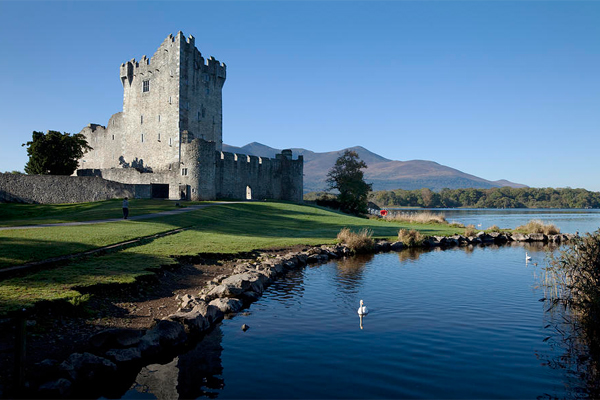
On The Map: Ross Castle is located on the southern outskirts of Killarney, County Kerry in the southwest of Ireland. From Killarney town centre, head south on the N71/Muckross Road for Kenmare. Ross Road is right turn off the N71, and is well signposted.
Ross castle overlooks the Lower Lake in Killarney, and commands magnificent views of Purple Mountain, Innisfallen Island & Ross Island. The Castle is a typical example of an Irish Chieftain stronghold during the Middle Ages. The date of its foundation is uncertain, but construction was most likely completed in the late 15th century, by one of the O'Donoghue Ross chieftains. The castle is surrounded by a fortified bawn, and its curtain walls defended by circular flanking towers, two of which remain. Ross was the last Munster stronghold to hold out against Oliver Cromwell's infamous British forces, before eventually being taken by General Ludlow in 1652. The castle contains an impressive collection of 16th & 17th century oak furniture. Legend has it that Brian Boru, Ireland's most famous High King was educated on the site of the castle by the Monks in the 9th Century. Please note that this is a very popular attraction, and visitors may experience a delay entering the castle during the busy summer months.
Killarney to Kenmare, County Kerry
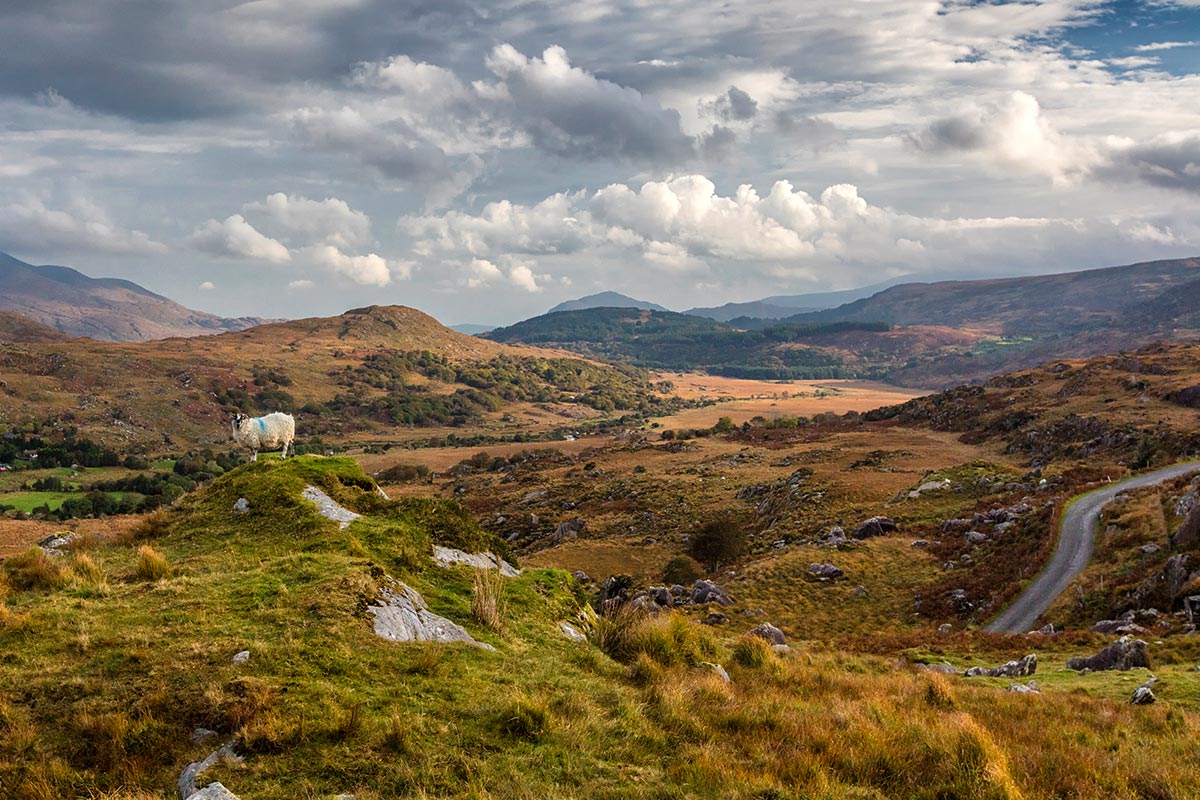
We appreciate that your time in Ireland is precious, and you simply won't be able to do absolutely everything. Completing the 110 mile Ring of Kerry, for example, might be a stretch on this tour. We do however highly recommend that you at least drive the section from Killarney to Kenmare (or vice-versa), which forms a portion of the Ring. It's only 30 kilometres/ 30 minutes each way on a narrow, winding road, but you are scenically rewarded at almost every turn. Highlights include 'Ladies View', so named for the excitement the vista illicited from Queen Victoria's Ladies-in-Waiting, during her famous 1861 visit. There's a little cafe and plenty of spots to pull in and admire the view that so stimulated the Royal Entourage 150 years ago! A little further along the road, you'll arrive at Moll's Gap. Set high on a rocky ridge, The Gap overlooks mountains, rivers, lush countryside and the famous Lakes of Killarney, with truly breathtaking views - Carrauntoohill, Ireland's highest mountain to one side, the Gap of Dunloe to the other. There's also an Avoca Store & Cafe at The Gap, selling the finest of Irish goods and souvenirs.
 Day 6
Day 6
Accommodation
18th Century Country House in the Burren - Lisdoonvarna, County Clare

Check in policies:
Check-in time is after 3:00pm on your day of arrival. Check-out time is before 11:00am.
Please contact the hotel directly if you cannot check-in before 6pm. +353 65 707 4026
Free parking is available on site.
Suggested Sightseeing
The Burren, County Clare

On the Map: The Burren is located in the north of County Clare in Ireland's west. The closest town is Ballyvaughan to the north, but the Burren is also easily accessible from Doolin, Lisdoonvarna (to the west) and Ennis (to the south).
The Burren, or Boireann, meaning Great Rock, is in County Clare. It is, without dispute, one of the most unique - and strangest - landscapes in Europe. The Burren occupies approximately 250 square kilometers. Bounded by the Atlantic on the west and rocked by Galway Bay to the north, it is a multi-layered landscape where rare and delicate plants have adapted in order to thrive and flourish between harsh crevices. Stroll the meadows, be astonished by the boulders, and read the trail marks and footprints that the ice age and volcanoes left behind. The Burren is littered with ancient and megalithic sites. The most dramatic of these is the Poulnabrone Dolmen, an impressive 5,000 year old portal tomb. Poulnabrone is one of the most famous megalithic monuments in Ireland. Just how the people of the time managed to get the truly massive capstone in place, is a mystery which continues to baffle archaeologists.
Cliffs of Moher, County Clare

On the Map: The Cliffs of Moher are located on the western coast of County Clare. The Cliffs are accessed via the R478 road that connects Doolin (to the north) and the seaside town of Lahinch (to the southeast).
The Cliffs of Moher are one of Ireland's top Visitor attractions. The Cliffs stand 214 metres (700 feet) tall at their highest point and range for 8 kilometres over the Atlantic Ocean on the western seaboard of County Clare. O'Brien's Tower, constructed by Sir Cornellius O'Brien in 1835, stands proudly on a headland of the majestic Cliffs. From the Cliffs one can see the Aran Islands, Galway Bay, as well as The Twelve Pins, the Maum Turk Mountains in Connemara and Loop Head to the South. There are two paths to take north and south along the cliff edge, providing spectacular views all the way. Construction of an award winning eco-friendly Visitor Centre was completed in 2007. The interpretive centre named 'Atlantic Edge' contains state of the art displays and visitor facilities. The grass-roofed building is cleverly set into the hillside - a unique cave-like structure which minimises the visual impact on this fabulously scenic location.
Enroute Sightseeing
Adare Heritage Village, County Limerick
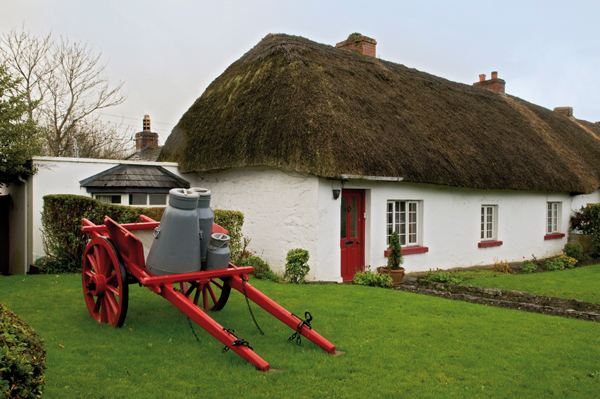
On the Map: Adare is located just 20km southwest of Limerick City / 43km south of Shannon Airport. The main N21 road (connecting the cities of Limerick & Tralee/Killarney) passes right through the centre of the village.
Adare is a quaint picturesque place, lined with traditional thatched-roof cottages. Snuggled in a wooded and lush countryside setting, Adare is widely regarded as being Ireland's prettiest and most unique village. Situated on the river Maigue, a tributary of the Shannon river, Adare (Gaelic name: "Ath Dara" - the "ford of the oak" - from the combination of water and woodland) dates back, at least, to the early 13th century. Adare village has a rich wealth of heritage, as well as architectural and scenic beauty. Two groups of world famous, ornate, thatched cottages line part of the village's broad main street, punctuated with beautiful stone buildings, medieval monasteries and ruins. Situated in the centre of County Limerick, with just 15 minutes from Limerick City and 45 minutes from Shannon Airport, Adare Village is an ideal base from which to explore County Limerick's many visitor attractions such as Lough Gur and King John's Castle.
Overnight Location
Lisdoonvarna, County Clare
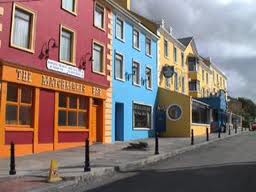
On the Map: Lisdoonvarna is located in north County Clare in the west of Ireland. The town is accessed via the N67 road that connects the cities of Ennistymon (to the south) & Kinvara (to the northeast).
Lisdoonvarna has been a spa town since the 19th century and today the Spa Wells Centre features sulfur baths, massage, saunas and other health facilities. The town is best known now for its Bachelor Festival in September founded to find wives for lonely farmers, who came here after the harvest was over and before winter set in. It's an attractive little place, with interesting shops and a choice of places to stay. You can see how local salmon is smoked and buy some to take home at The Burren Smokehouse in the town. At Lisdoonvarna you are on the edge of the Burren, one of the most unique landscapes in Europe which covers over 100 square miles and is truly a remarkable place.
 Day 7
Day 7
Accommodation
Scenic Luxury Hotel - Maynooth, County Kildare

Check in policies:
Check-in is from 3.00pm on your arrival day. Check out is from 12.00 noon.
Complimentary car parking on resort for all guests and visitors. Valet parking available upon request, subject to additional charge.
Suggested Sightseeing
Boyne Valley, County Meath

On the Map: The Boyne Valley is a fairly large region located in the east of Ireland in County Meath. Only 30 minutes/ 20km north of Dublin City, the Boyne Valley is accessed via the N2 or N3 roads heading northwest from the city.
The Boyne Valley contains the largest and most decorated megalithic sites in all of Ireland and has been described as "the largest and most important expression of prehistoric megalithic art in Europe". The large Megalithic sites were built over 5000 years ago between 3800 and 3200 BC, built before both Stonehenge in England and the great pyramids in Egypt. Within a three square mile radius in the Boyne Valley are grouped more than 30 prehistoric monuments including the great passage tombs and their satellite structures, standing stones, barrows and other enclosures. The great sites of the Boyne Valley include Newgrange, Knowth, Dowth, Loughcrew, Fourknocks and the Hill of Tara. Neolithic communities built these sites over earlier sacred spots and it is suspected that they were used for a combination of different purposes, including use as burial tombs, sacred temples and astronomical observatories. The nearby towns of Trim, Slane and Navan make ideal bases from which to explore the area.
Enroute Sightseeing
Galway, County Galway

On the Map: Galway is a coastal city, located in County Galway in the west of Ireland. Galway is well-served by a good network of roads - the M6/N6 from Dublin (to the east) and M18/N18 from Limerick & Cork (to the south).
In a recent nationwide survey the people of Galway were found to be Ireland's happiest! And visiting Galway City, the capital of their county it is not hard to see why. It is a lively university city of narrow streets, quaint shopfronts, bustling pubs and stunning surrounding scenery. It has always attracted a bohemian mix of musicians, artists and intellectuals and that attitude is palpable as you walk the streets. Galway has been commercially important since the 11th century when it was a centre for trade with Spain and Portugal. In 1477 Christopher Columbus paid a visit. Galway earned the title “City of the Tribes” around that time, when it was ruled by 14 wealthy merchant families. Today it is lively, with loads of things to do, and is so popular that it can get very crowded in summer, especially during the annual Galway Races. The annual Arts Festival also attracts thousands, especially for its street parade, organized by the multi-award winning production company, Macnas. Its famous Druid Theatre produces and stages plays and has toured internationally, winning awards, including Tonys on Broadway.
Clonmacnoise, County Offaly

On the Map: Clonmacnoise is located on the banks of the River Shannon in the very middle of Ireland. The major town of Athlone is only a few miles to the north, through which the main M6 road passes. The M6 connects Dublin City (to the east) and Galway City (to the west)
The ancient monastic site of Clonmacnoise is situated at the crossroads of Ireland in County Offaly and dates back almost 1,500 years. St. Ciaran, the son of an Ulsterman who had settled in Connaught, chose the site in 545 AD because of its ideal location at the junction of river and road travel in Celtic Ireland. The location borders the three provinces of Connaught, Munster and Leinster. The monastery is on the east side of the River Shannon, in what was then the Kingdom of Meath, but occupying a position so central it was the burial-place of many of the kings of Connaught as well as those of Tara. The site includes the ruins of a cathedral, seven churches (10th -13th century), two round towers, three high crosses and the largest collection of Early Christian grave-slabs in Western Europe. The original high crosses and a selection of grave-slabs are on display in the visitor centre. The long and varied history of Clonmacnoise is recounted in an audiovisual presentation shown in the visitor centre. There are also exhibitions that are dedicated to the flora, fauna and landscape of the region.
Overnight Location
Maynooth, County Kildare
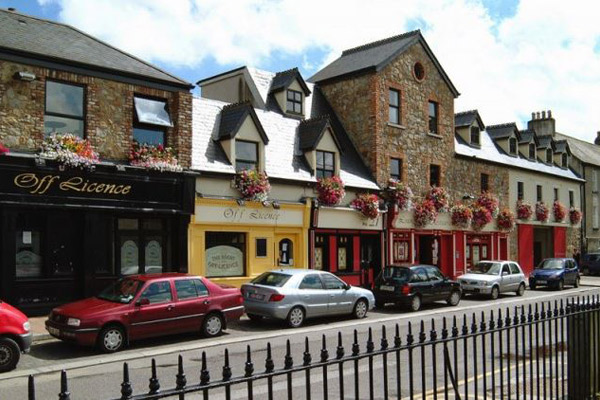
On the Map: Maynooth is located in County Kildare, inland from the eastern coast and approx. 30 minutes west of Dublin City. The town is just off the M4 motorway that connects the Dublin to Galway and Sligo.
County Kildare is home to the National Stud and three racecourses, at The Curragh, Naas & Punchestown. This inland county has areas of low-lying bogs on its western bountary. To the east, the foothills of the Wicklow Mountains meet its unique fertile plain, the Currage, which has 6,000 acres of grassland and; if up in the early morning, you can see beautiful throoughbred racehorses excerising. Visitors to Kildare can walk the countryside, play golf, fish, ride or cruise its waterways. One of the best ways of exploring this county is by following the canals, either walking their towpaths or cruising their waters. Away from the main roads, its a peaceful county with plenty of wild fowl, birds and animals in its river valleys, bogs, woodlands & canals.
 Day 8
Day 8
Accommodation
Historic Victorian 4-Star Hotel - Edinburgh, Central Scotland

Check in policies:
Check-in time is after 3:00pm on your day of arrival. Check-out time is before 11:00am.
Discounted car parking is available from a secure APCOA car park located a ten minute walk for the hotel. Bring your car to the front of the hotel to unload your luggage and receive directions to car park.
Included Unique Activities
Secrets of the Royal Mile & Edinburgh Castle

Discover an Edinburgh beyond the reach of tour buses and guidebooks. This beautiful city, steeped in awe-inspiring history, has been perfectly preserved. The wynds, closes, courtyards, and homes of Edinburgh’s Old Town are a journey through time. Come with us and explore the lives of generations of Edinburgh residents, from Mary Queen of Scots and Robert Burns, to the everyday folk who spent their entire lives within the city’s medieval walls. Your storyteller will enchant you as they walk with you through the culture, politics, and everyday events. You’ll see these tales evidenced in the present as you discover the Royal Mile. From the Royal Mile, you’ll walk straight over the drawbridge to Edinburgh Castle.
Suggested Sightseeing
Edinburgh Castle, Central Scotland
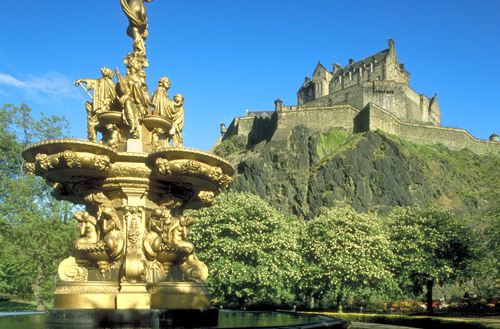
On The Map: Edinburgh Castle is located at the top of the Royal Mile, at the west end of Edinburgh's Old Town.
From its lofty position on Castle Rock, the castle dominates the Edinburgh skyline. There has been a fortification of some kind here for thousands of years. The castle has existed through layers of time and history, and it is indeed magnificent. Having etched the city’s skyline for 800 years, the Castle is a national symbol. A vital part in Scotland’s historic struggles, the castle houses the Crown Jewels of Scotland, the Stone of Destiny, the legendary 15th century gun Mons Meg, the One O' Clock Gun, and the National War Museum of Scotland. In addition to guided tours provided by the castle stewards, there is an audio guide tour available that takes you around the castle, explains its architecture, and tells its dramatic history.
Greyfriars Bobby and Kirkyard, Edinburgh, Central Scotland
.jpg)
Greyfriars Bobby was a Skye Terrier who became known in 19th-century Edinburgh for supposedly spending 14 years guarding the grave of his owner until he died himself on 14 January 1872. The story continues to be well known in Scotland, through several books and films, and a prominent commemorative statue and nearby graves act as a tourist attraction.
The best-known version of the story is that Bobby belonged to John Gray, who worked for the Edinburgh City Police as a night watchman. When John Gray died he was buried in Greyfriars Kirkyard, the graveyard surrounding Greyfriars Kirk in the Old Town of Edinburgh. Bobby then became known locally, spending the rest of his life sitting on his master's grave. In 1867 Lord Provost of Edinburgh, Sir William Chambers — who was also a director of the Scottish Society for the Prevention of Cruelty to Animals — paid for Bobby's licence, and gave the dog a collar now in the Museum of Edinburgh. Bobby is said to have sat by the grave for 14 years. He died in 1872 and was buried just inside the gate of Greyfriars Kirkyard, not far from John Gray's grave.
The Royal Mile, Edinburgh, Central Scotland
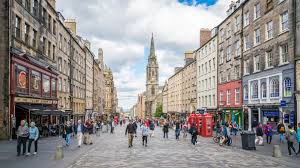
On The Map: The Royal Mile is located in Old Town Edinburgh, and runs between Edinburgh Castle & Holyrood Palace.
It has a number of famous historical sites and buildings, as well as an impressive array of shops, restaurants, and pubs. (The Royal Mile is actually more than a mile by 107 yards.) There are several independently named streets that connect, making up the Royal Mile. These are Castlehill, Lawnmarket, High Street, Cannongate, and Abbey Strand. The major attractions on the Royal Mile are Edinburgh Castle, Holyrood Palace, The National Museum of Scotland, and Camera Obscura—Scotland's oldest purpose-built attraction.
Edinburgh, Central Scotland
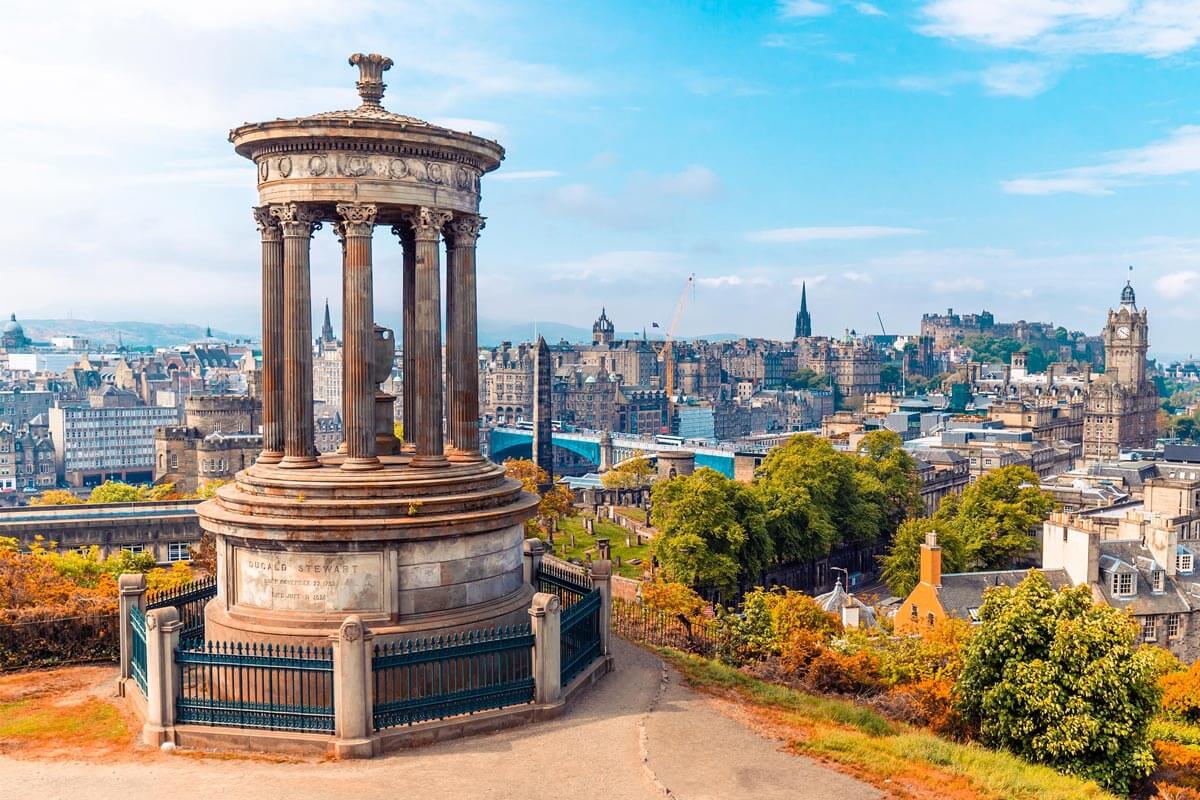
On The Map: Edinburgh is located on the southern shore of the Firth of Forth and is the capital of Scotland. Situated in Scotland’s Central Belt, the city center is 2 ½ miles southwest of the shoreline of Leith. Situated 332 miles north of London, and 46 miles east of Glasgow, Edinburgh is the bold heart of Scotland that invites exploration.
From ancient Edinburgh Castle, perched on a dormant volcanic plug, to narrow lanes and royal Georgian neighborhoods, this city is enchanting. Walk along the medieval walls. Expect surprising vistas and views of the sea. Discover quirky shops, whisky tasting, world-class restaurants, pub crawls, and friendly talk. Edinburgh is one joyous find after another.
Arrive at
One-way Flight from Dublin to Edinburgh, Central Scotland
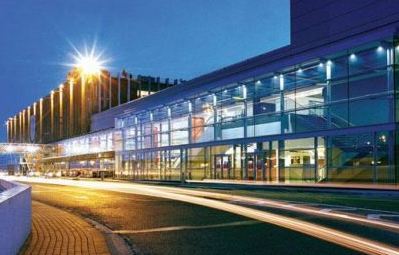
The flight time from Dublin to Edinburgh is just over an hour, making it by far the best option when travelling between Ireland & Scotland. Car ferries are simply too slow (and expensive), unless you have lots of vacation time to play with! There are multiple flights from Dublin to Edinburgh every day, and if booked a few months in advance, fares are very reasonably-priced.
Overnight Location
Edinburgh, Central Scotland

On The Map: Edinburgh is located on the southern shore of the Firth of Forth and is the capital of Scotland. Situated in Scotland’s Central Belt, the city center is 2 ½ miles southwest of the shoreline of Leith. Situated 332 miles north of London, and 46 miles east of Glasgow, Edinburgh is the bold heart of Scotland that invites exploration.
From ancient Edinburgh Castle, perched on a dormant volcanic plug, to narrow lanes and royal Georgian neighborhoods, this city is enchanting. Walk along the medieval walls. Expect surprising vistas and views of the sea. Discover quirky shops, whisky tasting, world-class restaurants, pub crawls, and friendly talk. Edinburgh is one joyous find after another.
 Day 9
Day 9
Accommodation
Historic Victorian 4-Star Hotel - Edinburgh, Central Scotland

Check in policies:
Check-in time is after 3:00pm on your day of arrival. Check-out time is before 11:00am.
Discounted car parking is available from a secure APCOA car park located a ten minute walk for the hotel. Bring your car to the front of the hotel to unload your luggage and receive directions to car park.
Included Unique Activities
Johnnie Walker Journey of Flavor

Join us on a journey through John Walker’s epic search for flavours that bring people together for enjoyment. Discover how, rather than settling for the status quo, Johnnie Walker’s pioneering spirit, resiliency, and bold, aspirational creativity continue to set us apart as drivers of innovation, social connection, and downright delicious drinks. Your full-sensory adventure culminates in a flavour-filled celebration of the legendary Johnnie Walker taste and the special moments we create and share together.
Your experience includes:
Full-sensory, 90 minute tour led by an expert guide
3 whisky drinks, tailored to your flavour preferences (non-alcoholic options are available too)
Please note that this experience does not include a visit to our bars. If you would like to reserve a table to enjoy drinks and dining in our 1820 rooftop bar or Explorers' Bothy bar before or after your experience, you can book your table online today.
*Note: This experience is highly immersive and uses a combination of flashing lights, media, music, sensory moments and special effects that may not be suitable for all audiences.
Suggested Sightseeing
Holyrood Palace, Edinburgh, Central Scotland
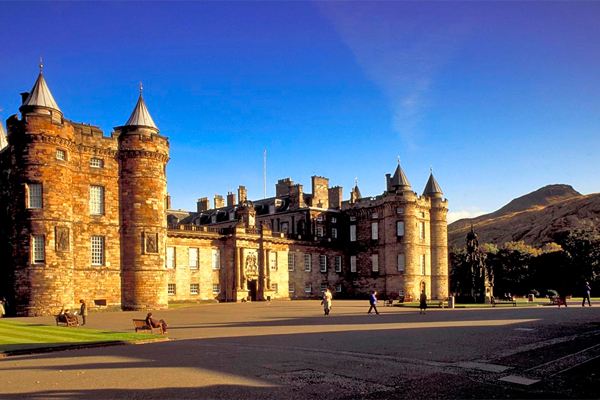
On The Map: The Palace of Holyrood House is located in the heart of the City of Edinburgh. The famous Royal Mile connects Edinburgh Castle at its western end and Holyrood to the east.
The official residence in Scotland of Her Majesty The Queen, this beautiful palace sits at the bottom of Edinburgh’s Royal Mile, sheltered by Arthur’s Seat. Holyrood has many strong ties in Scottish history, and is well-known for being the home of Mary Queen of Scots. Visitors can view the stunning Royal Apartments, which show the different tastes of each monarch with fine plasterwork ceilings and decadent furnishings. On a tour round the palace you can see the Great Gallery, hung with portraits by Jacob de Wet, of the real and legendary kings of the country, and see the display on the Order of the Thistle, the highest honour in Scotland. Visitors can also take a guided tour of the historic Holyrood Abbey ruins, and learn of the building’s fascinating history through the centuries from its beginnings in 1128. The Palace of Holyroodhouse is closed on Tuesdays and Wednesdays, except during July, August and September when we are open 7 days a week.
Edinburgh, Central Scotland

On The Map: Edinburgh is located on the southern shore of the Firth of Forth and is the capital of Scotland. Situated in Scotland’s Central Belt, the city center is 2 ½ miles southwest of the shoreline of Leith. Situated 332 miles north of London, and 46 miles east of Glasgow, Edinburgh is the bold heart of Scotland that invites exploration.
From ancient Edinburgh Castle, perched on a dormant volcanic plug, to narrow lanes and royal Georgian neighborhoods, this city is enchanting. Walk along the medieval walls. Expect surprising vistas and views of the sea. Discover quirky shops, whisky tasting, world-class restaurants, pub crawls, and friendly talk. Edinburgh is one joyous find after another.
Gilmerton Cove, Edinburgh, Central Scotland
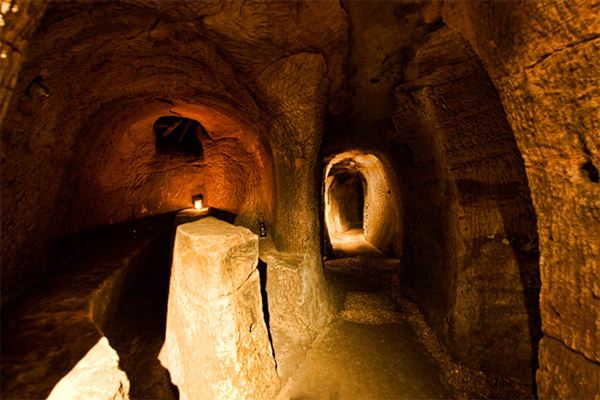
On The Map: Gilmerton Cove is located in the Gilmerton suburb of southeast Edinburgh. It's not walkable from downtown, but is served by the 3, 3a & 29 buses.
Gilmerton Cove is a series of strange, hand carved passageways and chambers that lie 10 feet below ground to the south of Gilmerton crossroads. After five years of work by Gilmerton Heritage Trust and The City of Edinburgh Council to restore and preserve it for future generations, it opened in August 2003, providing visitors of all ages with an educational and fun experience. The entrance to Gilmerton Cove is through a visitor centre adapted from a traditional mining cottage. This cottage now houses imaginative audio and visual displays that depict the various theories behind the origins of Gilmerton Cove which, after extensive archaeological and historical research, still remain a mystery. Just how old the caves are is unknown, but records go as far back as the 18th century and the system appears to be very much older. Who constructed them? When? Why? And what have they been used for over the years? Tomb of ancient kings? Meeting place for one or more persecuted religious groups? Masonic Lodge Room? Witches Coven? Illicit Whisky Still & Drinking Den? Knights Templar Retreat? Some theories even suggest that the Templars buried the Holy Grail here. Whatever the real answers, everyone can agree that it is truly a fascinating and mysterious site to visit. Daily tours are available by prior appointment - call 07914 829177. Please note that Gilmerton Cove is not located in the heart of Edinburgh. It's a 30-minute bus ride - use Bus No. 3 or 29 from Princes Street.
Royal Yacht Britannia, Edinburgh, Central Scotland
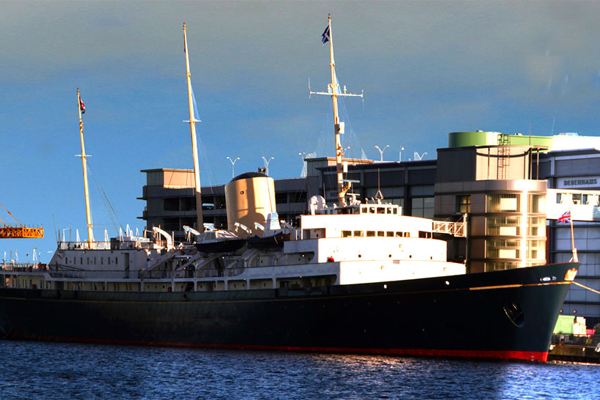
On The Map: The Britannia is berthed at Ocean Terminal, Leith - just 2 miles north of the heart of Edinburgh. Majestic Tour Buses depart regularly from Waverley Bridge in the centre of town, and stop at the Royal Botanic Gardens en route.
Discover the floating palace that served the British Royal Family for over forty years from 1954. This magnificent ship has played host to some of the most famous people in the world. But, above all, she was home to Her Majesty The Queen and the Royal Family. The Queen played a large role in the design of the ship, personally approving plans and choosing the furniture and decor. She was once quoted as naming the yacht as the one place she could truly relax. Now in Edinburgh you are welcome on board to discover the heart and soul of this most special of royal residences. Experience what life was like on board The Royal Yacht Britannia with a fascinating audio tour of five decks. Highlights of the tour include the elegant State Apartments, the Crew’s Quarters, the Engine Room and the stunning Royal Deck Tea Room. Complimentary audio guide in 22 languages. Open year round with free parking at Ocean Terminal.
National Museum of Scotland, Edinburgh, Central Scotland
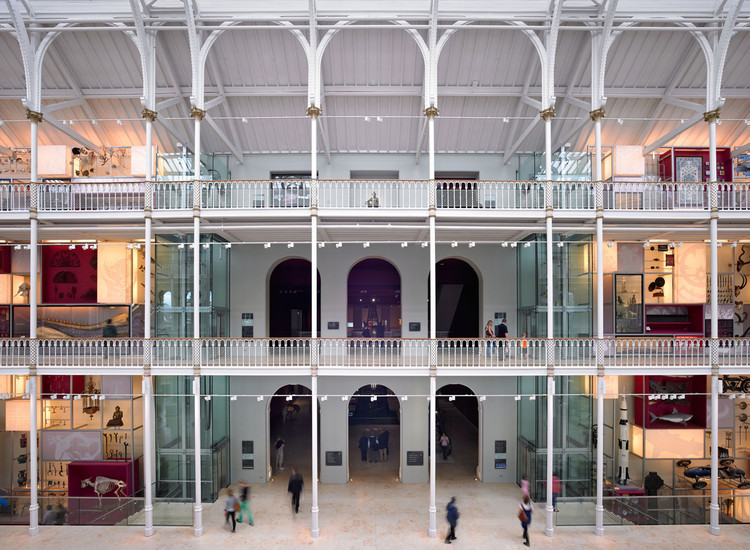
On The Map: The National Museum of Scotland is located on Chambers Street, in the heart of Old Town Edinburgh. Just a few minutes from the Royal Mile, Chambers Street links George IV Bridge and South Bridge.
The National Museum’s forte is artifacts from around the world. The recently opened, new modern Museum of Scotland, is a small miracle; it is dedicated to the story of Scotland and her people. The museums have different personalities, but they sit right next to each other. Together, they have one of the finest collections in the world. The rarest antiquities in Scotland create a treasure trove for the senses and imagination.
Some highlights include: Ivory chessmen made by invading Vikings in the 12th century; holy relics, one linked to St. Columba and Iona, and the other to Robert the Bruce; a staff carried by St. Fillian in the 8th century, one of the finest examples of artistry from 1,200 years ago; The Maiden, a 16th century guillotine; Bonnie Prince Charlie’s Canteen—everything he needed to travel and dine in style; Egyptian mummy cases, decorated with symbols of death and resurrection; and a 3,500-year-old Egyptian toy mouse with string that would have been pulled by a child. When it walks the tail wags!
 Day 10
Day 10
Accommodation
4-Star Landmark Luxury - Inverness, Highlands

Check in policies:
Check-in time is after 4:00pm on your day of arrival. Check-out time is before 11:00am.
Free parking is available onsite.
We advise that you make your dinner reservations before checking in by calling +44 1463 237 166 to be certain of availability. We are unable to promise that walk-ins will be guaranteed availability.
Enroute Sightseeing
Blair Castle, Pitlochry, Central Scotland
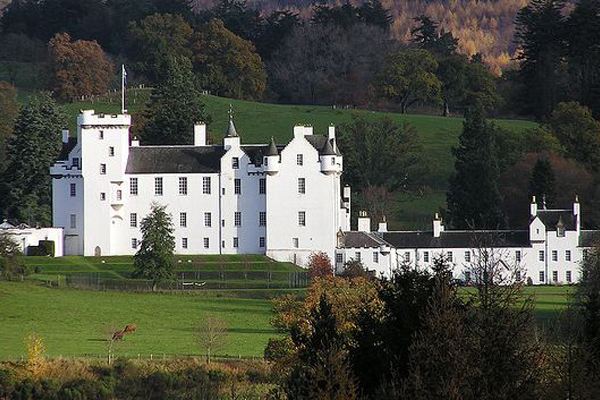
On The Map: Blair Castle is located in Perthshire in the centre of Scotland, just north of Pitlochry Town. The castle is accessed via the main A9 road that connects the towns of Inverness (to the north), and Pitlochry & Perth (to the south).
The only man in Europe still allowed to have a private army is the Duke of Atholl, who resides at Blair Castle! The sight of his magnificent, white castle on the main road north will stop you in your tracks. The oldest part of the castle was built in 1269. During the Jacobite campaigns, it was designed anew, and the turrets were added. A brilliant stroke of genius. The ancient seat of the Dukes and Earls of Atholl and home to the Atholl Highlanders, Blair Castle stands proudly against the magnificent backdrop of Highland Perthshire. With collections that fill over 30 rooms, there are few historic homes in Britain that can claim to have more comprehensive family treasures than Blair Castle, which portrays Scottish life over 700 years. After a tour of the castle you can enjoy the variety and tranquility of the grounds and gardens which form part of one of Scotland's great estates.
Pitlochry, Central Scotland
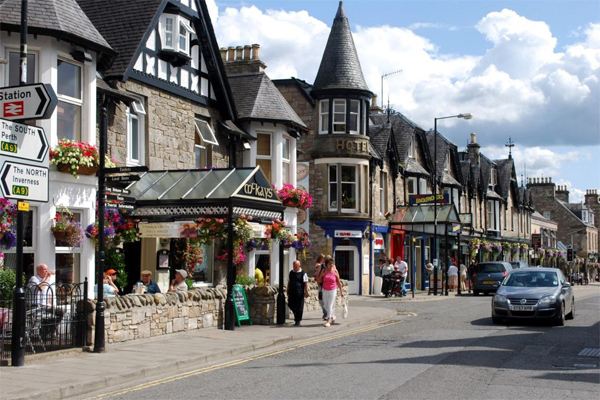
On The Map: Pitlochry is located in the very heart of Scotland. Cairngorms National Park is very close by to the north, and Edinburgh less than 1.5 hours to the south via the A9 road.
When Queen Victoria fell in love with the Highlands of Scotland, Pitlochry was a quiet village surrounded by the pine-covered hills of the Central Highlands. It became famous when she named it one of the finest resorts in Europe, and visitors began arriving to discover the magic of the Highlands. This vibrant town in the wooded valley of the River Tummel runs along a main street that’s lined with shops and eating places. It bustles with visitors, but relax and go with the flow. Look behind the busy-ness, and you’ll see the charming, Highland Victorian town that is still Pitlochry. Pitlochry is farther from the sea than any other place in Scotland, and it makes a good base for exploring the surrounding scenery, which is spectacular.
Cairngorms National Park, Central Scotland
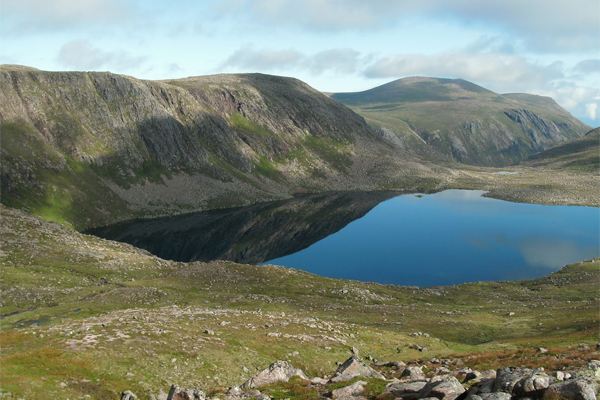
On The Map: The Cairngorms is Scotland’s largest National Park, and it occupies a huge region in the northeast. The nearest major town is Aberdeen to the east, but Cairngorms NP is central to all of Scotland's major cities.
The Cairngorms have the highest, rugged mountain range in Britain, rising to 4,296 feet. This country is heaven for walkers, skiers, rock climbers, and nature lovers. A number of rare bird species are attracted to the thriving, unusual alpine flora. Rock-climbers and skiers particularly love the challenge of the Cairngorms. Its craggy sides attract climbers from around the world—they practice at the Cairngorms before trips to the Himalayas!
During the summer, a funicular railway climbs Cairngorm. The views over the Spey Valley are spectacular. There’s also a steam railway, dating from 1863, that runs from Aviemore and Broomhila. This is a great way to get up-close to nature if you’re not into the thrills-and-chills of mountain sports. Also, many estates in the valley supplement their income by introducing visitors to the Highlands. See Britain’s only herd of reindeer and walk among them. The Cairngorm Reindeer Center is happy to introduce you to these lovely animals. With mixed woodlands at the base, and the summit forming a sub-polar plateau, the Cairngorms present a huge variety of flora. Ancient Caledonian pines, once common in the area, still survive in Abernathy Forest. Fragile and flourishing, Arctic flowers thrive in the heights.
Overnight Location
Inverness, Highlands
.jpg)
On The Map: Inverness is located on Scotland's central northern coast. The town is accessed via the A9 road from the southeast (Cairngorms National Park), A82 from the southwest (Loch Ness), and A96 from northeast Speyside.
Inverness is the gateway and true capital of the Highlands. It is also one of the Highland’s oldest settlements, and all roads still lead to the Highland’s center. Inverness feels like a compact town, but with 50,000 people it has the vibrant attitude of a lovely city. Let your imagination run wild and take a ghost tour, led by an 18th century ghost, complete with period costume. Expect to hear tales of the city’s past, including ghosts, witches, murders, and spells.
Stroll along the River Ness, or cruise on the Moray Firth, searching out bottlenose dolphins. (It is very peaceful, especially if you’ve just been ghost-hunting.) The River Ness flows through Inverness, and salmon fishermen come during the summer for a fine catch. Inverness Castle is perched high above the city, a gorgeous Victorian built of red sandstone. Just below the castle is the museum and art gallery which runs exhibitions and workshops for kids. The main shopping area fans out from there in three directions, and it includes a lively gathering place where pipers and other musicians gather and make music.
 Day 11
Day 11
Accommodation
4-Star Landmark Luxury - Inverness, Highlands

Check in policies:
Check-in time is after 4:00pm on your day of arrival. Check-out time is before 11:00am.
Free parking is available onsite.
We advise that you make your dinner reservations before checking in by calling +44 1463 237 166 to be certain of availability. We are unable to promise that walk-ins will be guaranteed availability.
Included Unique Activities
White Cottage Tea Room

Cream Tea is a delicous combination of scones with clotted cream (also called Devonshire cream) and jam. At White Cottage Tea Rooms, you'll find yummy home-baked nibbles, exceptionally welcoming hosts, speciality teas and coffees like Red Box organic tea and Eros fair trade coffee beans. They also have a range of gluten free and vegetarian options too. All of their our cakes, meals and drinks are also available to takeaway should you wish to enjoy a cream tea picnic!
Suggested Sightseeing
Inverness, Highlands
.jpg)
On The Map: Inverness is located on Scotland's central northern coast. The town is accessed via the A9 road from the southeast (Cairngorms National Park), A82 from the southwest (Loch Ness), and A96 from northeast Speyside.
Inverness is the gateway and true capital of the Highlands. It is also one of the Highland’s oldest settlements, and all roads still lead to the Highland’s center. Inverness feels like a compact town, but with 50,000 people it has the vibrant attitude of a lovely city. Let your imagination run wild and take a ghost tour, led by an 18th century ghost, complete with period costume. Expect to hear tales of the city’s past, including ghosts, witches, murders, and spells.
Stroll along the River Ness, or cruise on the Moray Firth, searching out bottlenose dolphins. (It is very peaceful, especially if you’ve just been ghost-hunting.) The River Ness flows through Inverness, and salmon fishermen come during the summer for a fine catch. Inverness Castle is perched high above the city, a gorgeous Victorian built of red sandstone. Just below the castle is the museum and art gallery which runs exhibitions and workshops for kids. The main shopping area fans out from there in three directions, and it includes a lively gathering place where pipers and other musicians gather and make music.
The Black Isle, Inverness, Highlands
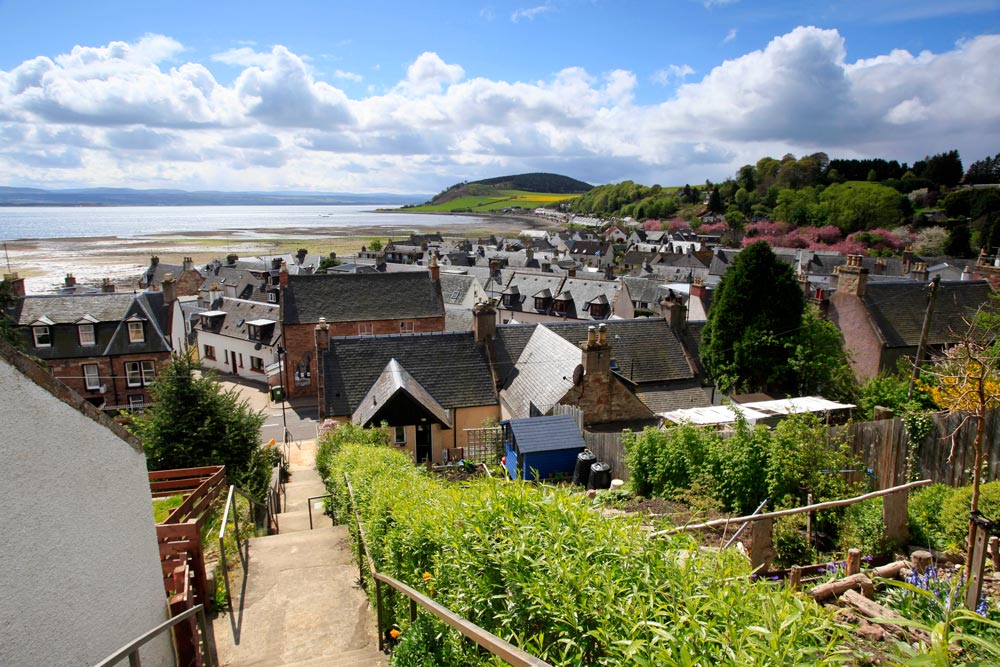
On The Map: The Black Isle is located just north of Inverness in the Highlands of Northern Scotland. Construction of the Kessock Bridge (completed in 1982 and part of the A9 road) has greatly aided to access to the peninsula. Despite its name, the Black Isle is not an island, but a peninsula, surrounded on three sides by water. The description ‘Black’ is just as misleading as Isle, and no one knows where the name originated. There are however a number of theories, the most colourful relating to the practice of black arts and witchcraft in mediaeval times. About 23 miles long by 9 miles wide at its broadest point, a drive around the peninsula, particularly if spending a few nights in Inverness, is well worth the effort. One of the Isle’s highlights is the village of Cromarty, poised on the tip of the peninsula. Probably the Highlands' best preserved historic town, Cromarty offers a wealth of attractions: sandy beaches, unusual architecture, Bottlenose Dolphins, pleasant eateries, and even a multi-award winning museum. Much of the village is original 18th century design, with little influence by modern-day architecture. The small fishing villages of Fortrose, Rosemarkie and Avoch are also highlights, located on the east coast of the Black Isle. Just across the water is the massive and imposing Fort George, built after the 1745 Jacobite Rebellion, in the hope of deterring any further unrest among the Highland Clans.
Cawdor Castle, Inverness, Highlands
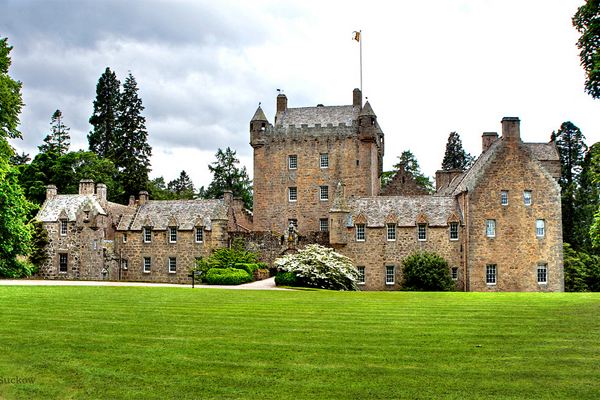
On The Map: Cawdor Castle is located in the north of Scotland. The castle is accessed via the B9090 road whichintersects with the main A96, northeast of Inverness Town.
Cawdor Castle has been the home of the Thanes of Cawdor since its construction in 1370. Originally consisting only of its central tower, the current structure is a result of significant additions in the 15th, 17th & 19th centuries. Well known for its fictional association with Shakespeare's Macbeth, Cawdor is also famed for its magnificent gardens, portions of which are over 300 years old. After you step inside, this other-worldly castle makes historical facts pale. Cawdor Castle fulfills all Shakespearean thoughts of love and tragedy. With its original keep, built in 1454, a drawbridge, ancient yew tree and enough weapons to start an uprising, this castle is the stuff of legend. The garden and estate, complete with maze, are equally remarkable. Who could ask for anything more? Cawdor Castle is open to the public between May & September each year.
Speyside, The Whisky Triangle, Elgin, North East
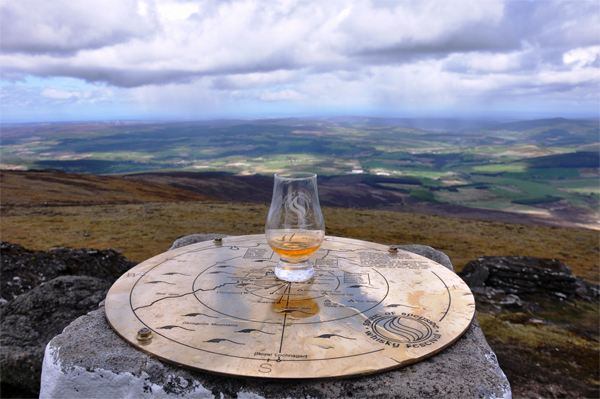
On The Map: Speyside is a name that is associated with the area between the towns of Elgin, Keith and Grantown, in the northeast of Scotland. The area is just about one hour drive east of the city of Inverness.
Speyside is a gentle area that feels more dreamlike than parts of everyday life. Signposts often read like a well-stocked bar! Whisky, a word derived from the Gaelic ‘uisce beatha’, means “water of life”. It has been distilled here, legally and otherwise, for more than 600 years. (The first record of making whisky in Scotland was in 1494.) Whether the Scots took it to Ireland, or the Irish brought it with them to Scotland in the 6th or 7th century, isn’t clear. There are eight distilleries, mostly founded in the early 18th century, linked by the signposted Malt Whisky Trail. Glen Grant, Cardhu, Strathisia, Glenlivet, Benromach, Dallas Dhu, Glen Moray, and Glenfiddich. Each offers guided tours and whisky tastings, and opening times and admission fees vary. But come to Speyside even if whisky is not on your agenda. This area is romantic and the River Spey is gorgeous.
Culloden Battlefield, Inverness, Highlands
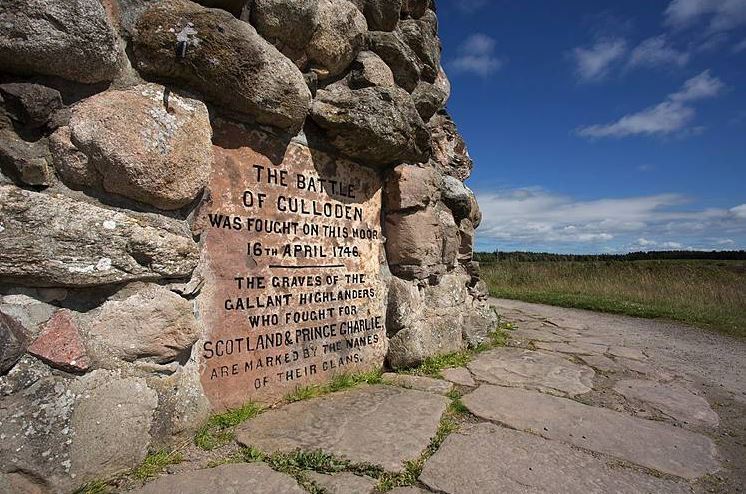
On The Map: Culloden Battlefiled is located just 15 minutes from Inverness in the north of Scotland. From Inverness, travel approx. 7 miles east on the B9006, Culloden Road. A daily bus service also runs from Inverness to the battle site.
Since the 1630s Britain had suffered political and religious upheaval. Civil war was a constant fear as Scotland, Ireland and England struggled to find a way to live and prosper together. The 1745 Jacobite Rebellion against the British Government, led by the exiled Prince Charles Edward Stuart ('Bonnie Prince Charlie') had had some success. However at 1.00pm on 16 April 1746, the Culloden Battle began. Hardly an hour had passed between the first shots and the final flight of the Prince's army. Although a short battle by European standards, it was an exceptionally bloody one, and would change the course of history in Britain. The exciting new Culloden Battlefield visitor centre and exhibition opened in December 2007. Through recent archaeological and historical research the National Trust for Scotland discovered that the previous centre was sited on the third Government line of the battlefield. With the Trust's resolve to return the battlefield to as original a condition as possible, the centre was moved. The new centre and exhibition allows the whole Culloden story to be told in an innovative and interactive way, which appeals to all the family.
 Day 12
Day 12
Accommodation
4-Star Traditional Riverside Hotel - Fort William, Highlands

Check in policies:
Check-in time is after 4:00pm on your day of arrival. Check-out time is before 10:00am.
Free parking is available on site.
Enroute Sightseeing
Fort Augustus, Highlands
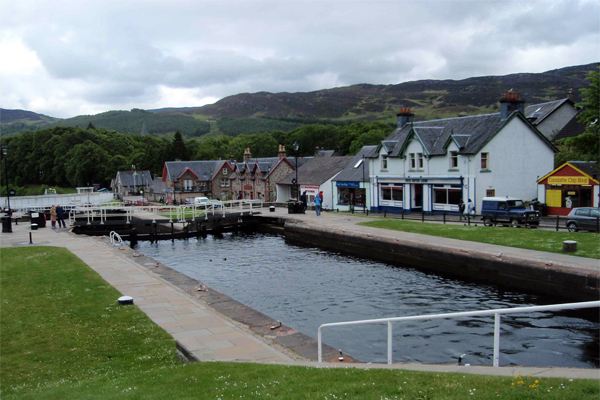
On The Map: Fort Augustus is located at the southern end of Loch Ness in the Scottish Highlands. The main A82 road connecting Fort William (to the southwest) and Inverness (to the northwest), passes right through town. Fort Augustus takes its name from the fort built in this location, after the defeat of the 1715 Jacobite uprising. It named after King George II's younger son, Prince William Augustus, who later became the Duke of Cumberland. The infamous "Butcher Cumberland" was responsible for repressing the Highlands and destroying the ancient clan system after the final defeat of the 1745 Jacobite uprising at Culloden. Today, almost nothing remains of the original fort, although parts thereof were incorporated into the Benedictine Abbey (pictured) when it was built in 1876. Fort Augustus’ main attraction (aside from the natural beauty of its surrounds) is the Caledonian Canal, which bisects the town. The canal connects Corpach near Fort William with Clachnaharry in Inverness, was completed in 1822, and at 60 miles long can be regarded as one of Scotland's greatest engineering feats. To the north the canal enters Loch Ness, and within the village itself is a series of stacked locks that provide a relaxing and entertaining spectacle. Immediately next to the locks is the Caledonian Canal Heritage Centre - an excellent place in which to gain an insight into the history and operation of the Canal. This area is part of a very attractive village centre, built along either side of the locks. The Clansmen Centre is another interesting diversion, where appropriately attired guides demonstrate 17th century clan weaponry, and provide insights into what clan life was really like.
Urquhart Castle, Highlands
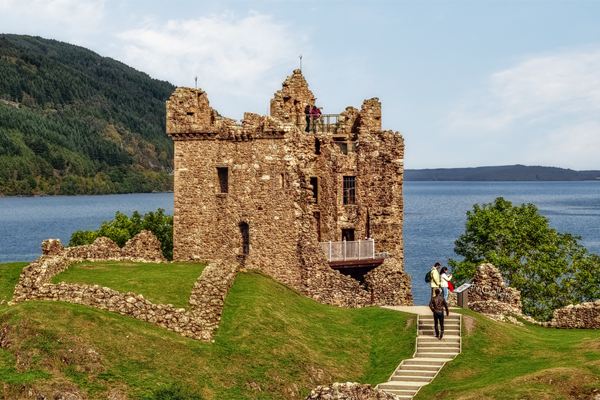
On The Map: Urquhart Castle is located on the western shore of Loch Ness in the northern Highlands of Scotland. The castle is approx. 16 miles southeast of Inverness on the main A82 road, in close proximity to the village of Drumnadrochit.
Wild natural beauty and 1,000 years of history - Urquhart Castle offers a taste of the Highlands at their most dramatic. Magnificently sited, overlooking Loch Ness, Urquhart is one of the largest castles in Scotland, and remains an impressive stronghold despite its ruinous state. Urquhart witnessed considerable conflict throughout its 500 years as a medieval fortress and its history from the 13th to 17th centuries was particularly bloody. Following Edward I’s invasion, it fell into English hands and was then reclaimed and lost again. In the 14th century, it figured prominently in the Scots’ struggle for independence and came under the control of Robert the Bruce after he became King of Scots. In the 15th and 16th centuries, the castle and glen were frequently raided from the west by the ambitious MacDonald Lords of the Isles, before ultimately falling into decay in 1689. The castle’s history and that of its noble families – Durward, MacDonald and Grant - is told in the exhibition and audio-visual display in the new visitor centre. The centre features an outstanding array of medieval artefacts found at the castle. The visitor centre contains retail, interpretation area, audio-visual presentation and tearoom and toilets on one level. The centre's veranda offers stunning views of the loch.
Loch Ness, Highlands
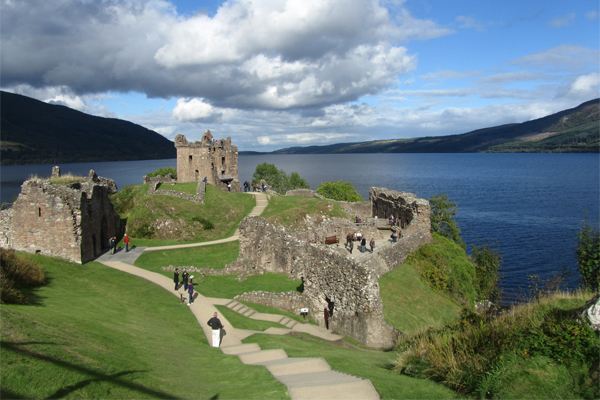
On The Map: Loch Ness is a long stretch of freshwater, extending 23 miles southwest of Inverness.
Loch Ness holds more water than all the lakes and reservoirs in the U.K. combined. During the Ice Age, glaciers deepened a trench halfway through Scotland, creating a long glen of steep, forested mountains and mysterious lochs. Castles and forts abound here, bearing witness to the Great Glen’s strategic importance. There is, of course, the elusive Loch Ness monster who still attracts scientific interest. Loch Ness is almost 1,000 feet deep and has unusually dark water, owing to the high peat content of the surrounding soil. This is an immensely atmospheric loch, surrounded by mountains, castles, abbey ruins, and several enchanting villages. The fame of Loch Ness is well-deserved.
Overnight Location
Fort William, Highlands
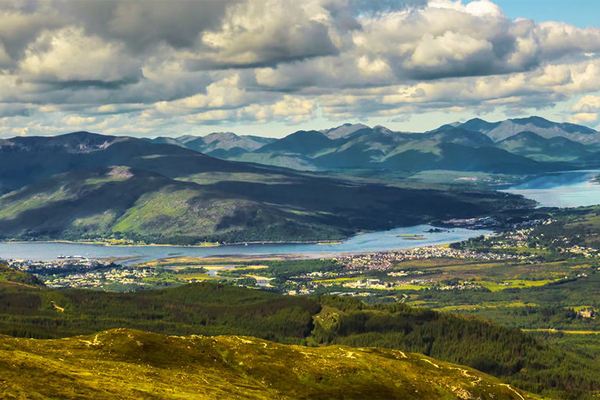
On The Map: Fort William sits at the head of Loch Linnhe, and the foot of the Great Glen and snow-peaked Ben Nevis. The major A82 road runs through town connecting it with Glasgow to the south & Inverness to the northeast.
Fort William got its name from the original fort built here in 1650 to keep the Highland clans in order. It's a convenient touring base for the Northwest of Scotland, and a popular hub for walkers, mountaineers, and scenery lovers of every type. Its appeal is not that of a destination town, but rather its location to some of the most stunning natural beauty in Scotland. Ben Nevis, Scotland’s highest, and most rugged is the most obvious draw, but it's certainly not all. The West Highland Museum on Cameron Square exhibits the 18th century “Secret Portrait of Prince Charles.” This was done when all paintings of Stuarts were completed in obscure swirls so the viewer didn’t get into trouble for having any connection, at all, to the Stuart side of the Royal family. Just northeast of town is the acclaimed “Treasures of the Earth,” one of Europe’s finest collections of crystals and gemstones. The “Underwater Center,” on the banks of Loch Linnhe, is the world’s leading diving instruction and training center. Also north of town are the impressive ruins of Inverlochy Castle.
 Day 13
Day 13
Accommodation
4-Star Traditional Riverside Hotel - Fort William, Highlands

Check in policies:
Check-in time is after 4:00pm on your day of arrival. Check-out time is before 10:00am.
Free parking is available on site.
Suggested Sightseeing
Glenfinnan, Highlands
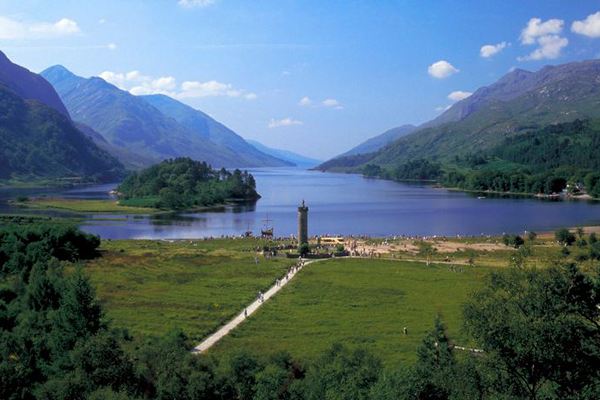
On The Map: Glenfinnan Village is located in the western highlands of Scotland, 10 or so miles from the coast. The Village is most easily accessed via the A830 road, 17 miles west of the town of Fort William.
This small, beautiful village has sat comfortably among the hills of Glen Finnan for centuries. The village is located within a lovely u-shaped valley that follows a north-east to south-west route with Loch Shiel in the center of the glen. Of major interest is the Glenfinnan Monument (pictured). The column, erected in 1815 is a tribute to the Jacobite clansmen who fought and died in the cause of Prince Charles Edward Stuart (Bonnie Prince Charlie). The raising of the Prince's Standard took place at the head of the loch on 19 August, 1745, in a last attempt to reinstate the exiled Stuarts on the throne of Great Britain and Ireland, Unfortunately for the Prince and his followers, their campaign came to a grim conclusion in 1746 on the battlefield at Culloden. The nearby Glenfinnan Viaduct is also well worth a visit. This wonderful piece of late Victorian construction was completed in 1901, and the viaduct was the first structure in the world to use at that time the new building material 'Mass Concrete'. Over 100 feet in height and made up of 21 arches, this viaduct is a beautiful piece of engineering and is a glorious sight. The viaduct has recently gained notoriety from its use in the Harry Potter films, as the Hogwarts Express winds its way to Hogwarts Castle.
Steall Waterfall, Glen Nevis, Highlands
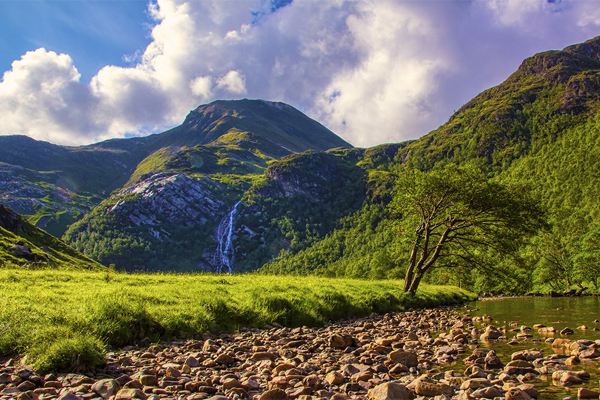
On The Map: Steall Falls is located in Glen Nevis, just 15 minutes drive southeast of Fort William.
Steall Waterfall takes its name from the gaelic 'An Steall Bàn', which means The White Spout. And quite a spectacular spout it is at almost 400 feet tall - the second highest in Scotland. It is a relatively short hike to the falls from the Lower Falls carpark - between 30 & 45 minutes each way. Serious walkers wishing to indulge in a longer hike can instead leave their cars at the Braveheart carpark. The path through Nevis Gorge is well-maintained and straight-forward, but of course good footwear is essential. The gorge is the epitome of Highland beauty, as you find yourself surrounded by superb views, wild flowers, cascading streams and most likely some grazing Highland cattle! Soon the gorge opens-up to reveal a hanging valley, into which Steall Waterfall makes its impressive drop. Walk on for another 15 minutes or so, and you'll arrive at the wire rope bridge, where one can test their nerve in pursuit of a close-up waterfall view! If you are a Harry Potter fan, Steall Falls is featured in a few scenes such as the famous battle between Harry and the Horntail dragon in the Goblet of Fire.
Glencoe, Highlands
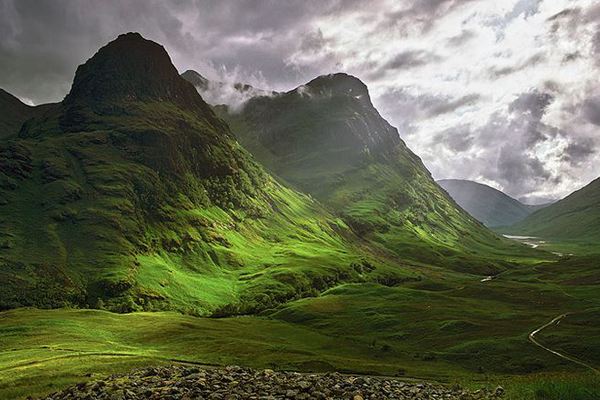
On The Map: Glencoe runs east-west along the route of the main A82 road. Fort William is a mere 16 miles to the north, while Glasgow is 90 miles to the south
'Glen Coe' is probably Scotland’s most famous and scenic Highland glen – and deservedly so - it really does merit the description 'spectacular'. The best approach is from the south on the A82, one of the major routes through the Highlands. The road climbs over the bleak expanse of Rannoch Moor and drops down between the steep scree-strewn sides of Glencoe. Awesome mountains such as Buachaille Etive Mor and the Three Sisters loom on either side, with riverine scenery at the bottom of the glen. The area is a paradise for walkers and climbers in all seasons, and skiers and snowboarders in the winter. The name Glencoe means 'Valley of Weeping', and has a haunting atmosphere as a result of the Massacre of Glencoe in 1692. This was carried out by the British army, when the chief of the MacDonalds of Glencoe had been slow to swear allegiance to William of Orange. The picturesque village of Glencoe lies at the northwest end of the glen. In the TV series Outlander, Glencoe features in the show's opening credits. It has also starred on the big screen, in Harry Potter movies, Highlander and Rob Roy.
Ben Nevis, Highlands
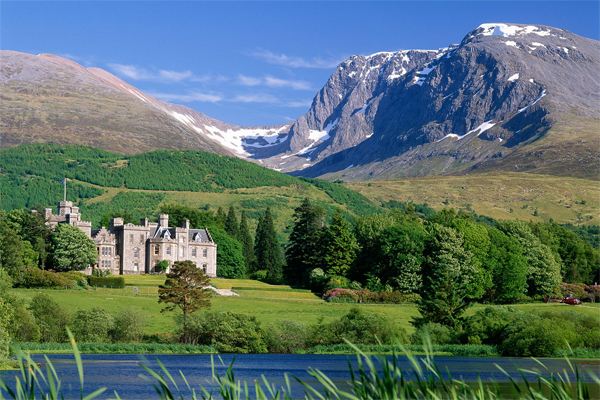
On The Map: Ben Nevis is just a 10 minute drive southeast of the town of Fort William in the west of Scotland. The major A82 road runs through town connecting it with Glasgow to the south & Inverness to the northeast.
At 4,406 feet, Ben Nevis is not only Scotland’s, but Britain's highest, and most rugged, mountain. Just a 10-minute drive from the town of Fort William, it is set in the Highlands' most impressive glen - a classic glacial valley hemmed in by steep slopes and swathes of blue-green stones. Herds of shaggy Highland cattle graze the valley floor where a sparkling river gushes through glades of trees. With Ben Nevis, huge and imposing to the north, it’s not surprising that this valley was the location for film scenes from many movies including Rob Roy and Braveheart. The five-mile climb to the top of Ben Nevis, along a well-beaten path, is doable for most people who are reasonably fit. The summit is reached by way of Glen Nevis, often called Scotland’s most beautiful glen. The rewards of making the climb are huge. From the top you can see the Cairngorms, the Cuillin range on Skye, and the peaks of Argyllshire. On a very clear day, you may even get a glimpse of Northern Ireland. Spell-binding. Want to really get high? Take the UK’s only mountain gondola on one of the nearby peaks. Halfway up there’s a restaurant and bar, and in the winter it’s a great ski area.
 Day 14
Day 14
Accommodation
Stylish Modern Hotel - Glasgow, Central Scotland

Check in policies:
Check-in time is after 3:00pm on your day of arrival. Check-out time is before 11:00am.
Validated car parking is available from £15 per day at Cambridge Street and Charing Cross car parks. Both car parks are within 10 minutes walk of the hotel. On-street parking is available around the hotel for £4 per hour.
Suggested Sightseeing
Kelvingrove Art Gallery & Museum, Glasgow, Central Scotland
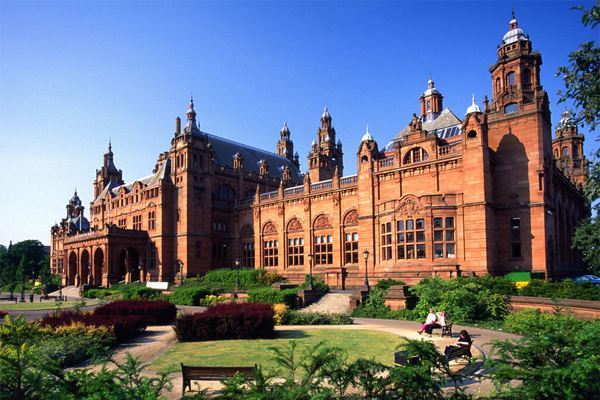
On The Map: Kelvingrove Art Gallery and Museum is located in the west end of Glasgow. From the city centre, the 9, 16, 23, 42 and 62 buses all stop directly outside the museum
Originally opened in May 1901, Kelvingrove Art Gallery and Museum is Scotland's most visited free attraction. With 22 themed, state-of-the-art galleries displaying an astonishing 8000 objects, the collections are extensive, wide-ranging and internationally-significant. They include: Natural History, Arms and Armour & Art from many art movements and periods of history. Kelvingrove welcomes families with children, and its displays have been designed with children in mind. There are lots of interactives throughout the museum that will appeal to younger audiences. There's even a real Spitfire aircraft on display! The RBS Exhibition Gallery and the Community Exhibition space both have a running programme of temporary exhibitions and displays. Please note that some temporary exhibitions are subject to an entry fee. When visiting Kelvingrove you can also enjoy its wonderful cafés and shops.
Glasgow Necropolis, Central Scotland
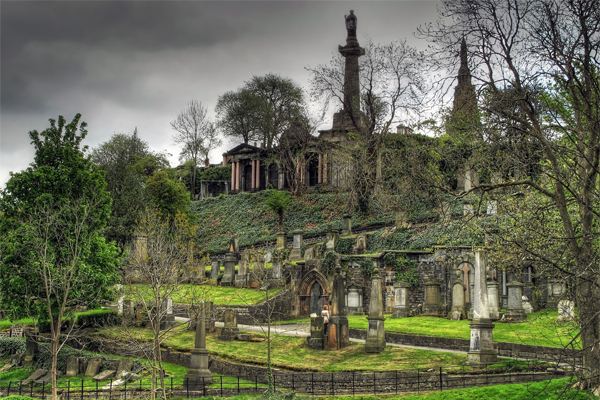
On The Map: The Necropolis stands on a hill to the east of Glasgow Cathedral, just a short walk across the Bridge of Sighs. From George Square in the heart of Glasgow, the cemetery is a 15 - 20 minute walk to the east. Built in the Classical Revival Architectural fashion, the Necropolis was established by the Merchants' House of Glasgow in 1831. Located atop the second tallest hill in Glasgow, the site is regularly described in terms of peace, serenity and calm. The cemetery, like several in Edinburgh, was modeled on Père-Lachaise in Paris. It has been estimated that in the order of 50,000 burials have taken place here, with around 3500 tombs. The monument to John Knox, which was erected in 1825, dominates the hill. Because the hill is solid rock, many of the graves had to be blasted from the rock-face. Walking tours are run by well informed, volunteer tour guides, and should be pre-booked. Self-guided tours are also possible, and an easy to follow pocket guide to 60 of the most famous monuments is available on-site.
Enroute Sightseeing
Stirling, Central Scotland
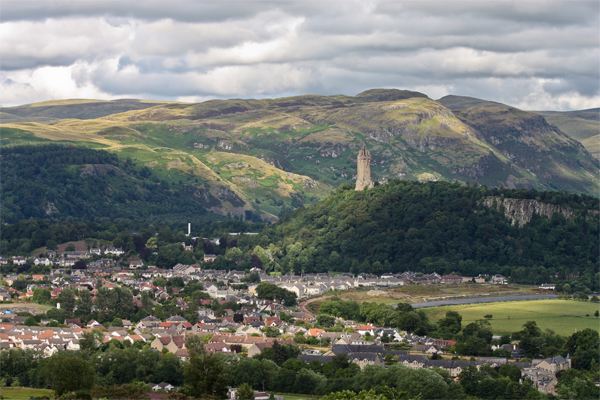
On The Map: Stirling is located in Central Scotland, less than 45 minutes on the M80/A80 from Glasgow to the southwest and 1 hour on the M9 motorway from Edinburgh to the southeast.
Stirling is a taste of both the Lowlands and the Highlands. It is packed with castles and tales of people who are larger than life, and it is blessed with awe-inspiring natural beauty. “Hold Stirling and you control the entire country…” This simple strategy has ensured that a castle, or some sort of fortification, has existed here in Scotland since prehistoric times. Stirling is associated with King Arthur, and some believe it was the locale for Camelot.
In recorded history, we know that Alexander I dedicated a chapel here. Below the impressive Stirling Castle, Old Town Stirling is protected by 16th century walls built to keep Mary, Queen of Scots, safe from Henry VIII. And, it was here that the infant James VI was crowned in 1567. This area was also home to Rob Roy, whose exploits still echo through the Highlands. There is something about Stirling that feels like a fairy tale. Its sense of time is similar to Edinburgh, but the hustle and bustle is turned down. With its winding cobblestone streets, and the old town clinging to the slopes beneath the castle, you can feel the layers of time and heroism. Take a quiet walk in the moonlight on Stirling’s magic streets. It’s an experience to be savored.
Overnight Location
Glasgow, Central Scotland
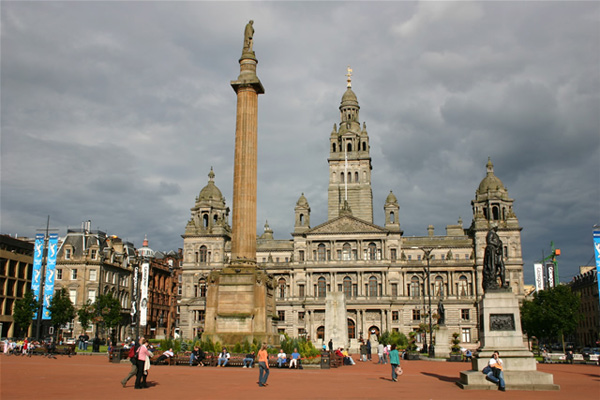
On The Map: Glasgow is located in the southwest of Scotland. The city is well served by a good network of roads and motorways, including the M8 from Edinburgh to the east, and M74 from Carlisle, England to the south.
Glasgow, Scotland’s largest city, is vibrant and downright sassy. It bubbles with sensational cuisine and raucous nightlife. Along the revitalized River Clyde, you’ll discover Glasgow’s seagoing heritage as you wander the riverfront walkways. Museums, galleries and trendy street-cafes abound. The extraordinary Kelvingrove Art Gallery and Museum is a marvel. Listen to the music pouring out of pubs—it’s among the best home-grown sounds in Britain. Step inside and nurse a pint of local brew in one of the city’s perfect watering holes. Scotland’s largest city is a cultural dynamo--no false pretences in Glasgow. Its urban mayhem and offbeat style lets you know that this city is all about fun, friends, and the joy of life. Glasgow is a metropolis that is 100% gregarious and down-to-earth.
 Day 15
Day 15
Depart From
Depart from Glasgow Airport, Central Scotland
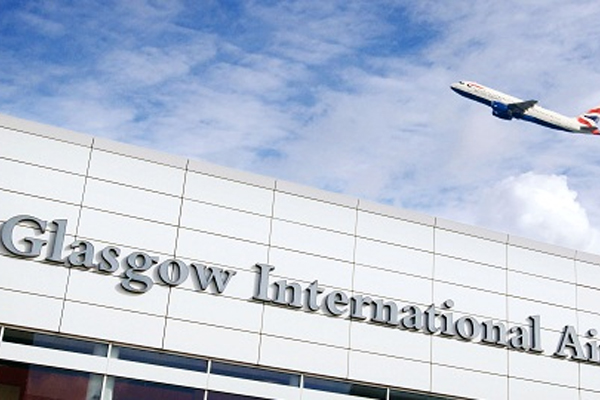
Arrive at Glasgow Airport at least 3 hours prior to your flight's scheduled departure. This will allow ample time to check in for your flight home.
2024 LOW SEASON
Available Dates
Nov, Dec
ON SALE! From $4,398 $4,198 per person
2024 MID SEASON
Available Dates
Sep, Oct
ON SALE! From $5,418 $5,218 per person
2024 HIGH SEASON
Available Dates
Jul, Aug
ON SALE! From $5,738 $5,538 per person
2025 LOW SEASON
Available Dates
Jan, Feb, Mar
ON SALE! From $4,502 $4,302 per person
2025 MID SEASON
Available Dates
Apr, May, Nov, Dec
ON SALE! From $4,618 $4,418 per person
2025 HIGH SEASON
Available Dates
Jun, Jul, Aug, Sep, Oct
ON SALE! From $5,689 $5,489 per person
Your Price Includes
ACCOMMODATION
- 14 nights Authentic Accommodations
TRANSPORTATION
- Automatic Rental Car in Ireland & Scotland
DINING OPTIONS INCLUDED
- 14 Full Irish & Scottish Breakfasts
UNIQUE EXPERIENCES
- Meet & Greet Private Transfer on Arrival in Dublin
- Enjoy a Tour & Pint at the Guinness Storehouse
- Join a Musical Pub Crawl through the streets of Dublin
- Kilkenny Castle Admission
- Flavors of Johnnie Walker Princes Street
- Secrets of the Royal Mile & Edinburgh Castle tour
- Cream Tea in Inverness
POINTS OF INTEREST
- Marvel at 6th Century Glendalough & Medieval Kilkenny
- Explore Stunning Scenery in County Kerry
- The Rock of Cashel & Adare Heritage Village
- The Cliffs of Moher & Globally Unique Burren Region
- Explore The Breathtaking Scottish Highlands
- Visit Scenic Loch Lomond & Mysterious Loch Ness
- Fascinating History & Scenic Beauty at Glencoe & Glenfinnan
Prices Based On
- All Taxes & Fees Included
- Prices are Per Person based on 2 people traveling together and sharing a room.
- Traveling Alone? No Problem. Just Ask Us for a Single Supplement Price.
"Family Vacation in Italy"
Jul 19, 2024Amber W.
Amarillo, Texas
Amber was amazing! She listened and came up with an itinerary that was more than we could have asked for and checked every box! She was available and responsive every step of the way. She happily answered any and all questions and provided great insight and suggestions along the way. Thank you for making this process invaluable.
"70th Birthday Celebration in Scotland"
Jun 30, 2024Douglas B.
Damascus, PA
Our trip to Scotland exceeded all our expectations. We were fortunate to be the only ones in our group so had the ability to add stops and learn a lot more. This was especially due to our amazing guide May Chen who is now a good friend. She really knows her geography, geology, history and how to show someone new around Scotland. She is a great driver as well and she was so responsive to all our needs and wishes.
"Wonderful Paris & London Trip"
Jun 27, 2024Betsy W.
Modern Travel Pros
I wanted to pass along some feedback from my clients who just came back from their Paris and London trip. I do think they had a wonderful time!
"I wanted to say thank you for all of your hard work and help in making this trip amazing for us. It was truly incredible and exceeded our expectations. Gary was spectacular and I’d recommend him a thousand times over. We were very happy with all of your hotel selections. Locations were great for everything. Let your Disney lover clients know they truly don’t need more than a day at Disneyland Paris. I can’t stress enough how perfect the location was for our hotel in London. Public transportation is soooooo easy to navigate from there and you are truly in the center of everything. Our hotel in Paris was great too. The entire city is just absolutely stunning. Paris is a bit more spread out than London so it’s tougher to be in the middle of everything, but that location was great. Super close to the subway and great food options within walking distance. I wouldn’t have changed anything about any of our hotels."
"Great trip to Paris, Italy and Switzerland"
Jun 27, 2024Betsy W.
Modern Travel Pros
My clients had a great trip! Here is their feedback: "Paris was Hannah’s favorite and I thought Switzerland would be mine, but it ended up being Venice. Switzerland was a close second! Overall, it was an amazing trip with wonderful memories to share. Thank you for all your help!"
"We got to see all of Ireland!"
Jun 27, 2024Craig & Mary
10
It was a great Small Guided Vacation and we got to see all of Ireland. North to South and all the little points and villages. The Wild Atlantic, West coast, Cliffs of Moher, Giants causeway....Galway and Dingle Peninsula were my favorite and the Blarney castle. I never knew all that stuff was still going on in Belfast with the walls and the separation. The black cab tour was excellent. Cork, and Kilkenny were all great. I bought the Aran sweater and the wife got hers plus a Claddagh ring with earrings and a necklace. Don't worry for all 14 days I had my fill of Guinness. Lots of pictures too. Thanks for everything!
"I just LOVE LOVE LOVE working with Authentic!"
Jun 26, 2024Izhar N.
CA
My clients returned from their whirlwind Scottish adventure...loved it !!!...they were able to do everything Bob wanted, and, even Shelly enjoyed the distilleries. Her favourite, actually, was hiking on the Isle of Islay...so, guess it was all worth it!! I, personally, want to say that your ground staff were FABULOUS!!!! Things happen...but, it was all sorted, and both I and my clients were extremely appreciative!! Again, I just LOVE LOVE LOVE working with you and Authentic !!!!
"Our Scotland trip was fantastic"
Jun 26, 2024Steve & Jeanine G.
10
Hi Katie, we wanted to let you know that the trip was fantastic. The accommodations were awesome--particularly Witchery and The Old Manse. All excursions and car rental went smoothly. Thanks for all your help.
"We had an AMAZING time in Italy!"
Jun 26, 2024Tamara L.
Agency
Hi Katie, here is a great feedback from my clients who just came back from Italy:
This was an amazing experience and the trip of a lifetime. We will absolutely return to Italy, and look forward to working with you to help us plan another great itinerary! Even though we are still shaking off some serious jet lag from the trip home, we are still basking in the glow of a wonderful trip and enjoying reflecting on the memories. Thank you so much for your help and making this trip a reality for us!
1. Click the “GET QUOTE” Button Above.
Complete our inquiry form by selecting your departure date, and all other relevant fields. Be sure to let us know if you're traveling for a special occasion! We can adjust most of our vacation packages to suit your needs, based on the details you provide.
2. Online Account & Quote Created
Your request will be forwarded to our team of Destination Experts, and a price quote will be prepared, based on your submitted preferences and criteria. A free Authentic Vacations online account will also be created, allowing you to view and request changes to your quote at any time. Log into your account via “LOGIN” at the top of any of our webpages.
3. Fine-Tune Your Tour Quote
Work with your assigned Destination Expert to tweak your quote in any way you wish. Our customers continually tell us that our flexibility in this regard is exceptional – your Destination Expert’s sole brief is to create the perfect tour for you!
4. Reserve & Pay Online
Once your quote is 100% to your liking, you can pay for your package with your credit card via your Authentic Vacations online account. We also accept payment by personal check and wire transfer. We only require a 20% deposit to secure your vacation, and our Risk-Free Cancellation Policy provides you with complete peace of mind.
5. Print Your Travel Documents & Go!
Once your vacation has been paid in full, you will be able to print your travel documents directly from your online account. You’re ready to embark on your ideal, authentic vacation!!
Questions?
If you would prefer to discuss your perfect vacation on the phone, we would be delighted to hear from you! Our Destination Experts are standing-by and looking forward to speaking with you at any time during our business hours listed below. We also operate a very responsive and efficient Live Chat service on our website…instant gratification awaits!
Toll-free from the US and Canada: 1-888-443-5259 Rest of World: +1-707-687-0191
Hours of Business:
Monday – Thursday: 7:00am – 5:00pm PST
Friday: 7:00am – 4:00pm PST
Saturday: 6:00am – 3:00pm PST
Sunday: 6:00am – 3:00pm PST
With offices in Scottsdale, San Francisco, London, Dublin, Copenhagen and Edinburgh, we can offer you unrivaled support while you are abroad. We truly believe all our clients deserve an extraordinary, authentic experience!






















